Top 100 All-Time Adventure Games page 2

Adventure games have been around for over forty years! Hard to believe, isn’t it? We’ve seen plenty of classics over the decades, and new gems are still being produced today. With such a rich history, just how many deserve to make a list of all-time greats? Our previous compilation of top adventures had 20 games listed, but that was nearly ten years old itself. So what would it be this time? 25? You’d be amazed how quickly those slots filled. 50? That leaves far fewer casualties, but some series alone can easily stake a claim to three or four slots.
Why not Best 100 Adventure Games?
While much of the world probably couldn’t even name 100 adventure games, those of us who cut our teeth on the groundbreaking early text titles, basked in the Golden Age of graphic adventures, suffered through the dark times and lived to see the modern-day (relative) renaissance know better. It’s not only possible to think of 100 quality adventures, it still leaves some painful omissions.
With a number in mind, that left one important consideration. What constitutes “the best”? How do you compare games spanning decades of styles and technology? Is a now-antiquated genre pioneer from 1985 still a classic today? Does it need to be? Do new games have any right to stand alongside their forebears that paved the way and have stood the test of time? What’s really important? Longevity, innovation, production values, historical relevance? What’s more crucial? Story, exploration, puzzles?
The answer is: all of the above – or none! There’s no scientific formula. It’s a combination of factors that depends entirely on the context for each individual game. You can debate each choice, each placement, and we hope you will! The beauty of opinion lists is that there’s no right or wrong, and we argued long and hard among ourselves just to arrive at ours. Sometimes we even contradicted the site's own reviews. But we’re completely confident that our final selections are deserving candidates and a wonderfully diverse representation of the genre’s best to date. Not every game will suit every taste, but there’s plenty of must-play gaming for all in our top 100 all-time adventure games.
Where can I buy old Adventure Games
Nowadays you can play most of these all time old graphic adventure games on modern systems, thanks to the help of ScummVM and GOG. You can buy most of the below adventure games directly on GOG.com, to be played instantly on your modern system.
We cannot talk classic adventure games without mentioning Big Boxes, the thrill and excitement of holding a Big Box PC game that features amazing art at the front and holds a manual and game disks is one that is still appreciated to this day. Many modern releases of Adventure Games have a Big Box being offered, either through a Kickstarter pledge or through platforms like Limited Run Games. If you however want to acquire the old game boxes, it's easiest to acquire them through eBay.
The top 100 Best Adventure Games!
First up: #100 - 96...
#100 – Titanic: Adventure Out Of Time

If you could go back to 1912, the maiden voyage of the RMS Titanic would surely be among the last destinations you’d choose. Unless you’re a former British spy, magically given a second chance to relive the terrifying night of April 15th in order to successfully fulfill the mission you failed the first time around, possibly preventing both World Wars in the process. Or if you’re an adventure gamer looking to live vicariously through the ordeal yourself – if you manage to survive, that is. In Titanic: Adventure Out of Time, CyberFlix’s 1996 alternate reality tale lets you do just that. You can admire the meticulously researched, faithfully recreated luxury liner with all the other passengers, but you do have an important task to accomplish before the night is out, some of which will be spent in a race against time as the ship begins its inevitable descent into the icy Atlantic waters. Given the tragic outcome of the journey for its 1500-plus victims, this game isn’t the next-best-thing to really being there… it is much, much better.
Digitally rendered from real historical documents and photos, the setting here is the real star of the game, offering a free-roaming virtual tour of the ship’s sights. Puzzles are fairly sparse, but you will need to perform such tasks as disarming bombs, repairing mechanical malfunctions and sending telegraphs using Morse Code. As you begin to interact with numerous other characters, each with their own stories to tell and secrets to hide, it’s important to say and do the right things at the right time. Often there are second chances to correct mistakes, but there are branching paths and multiple endings, not all of them ideal. The stakes really soar after colliding with the iceberg, as the lower levels are cut off by rising water levels and the ship begins to visibly list. Between impressive cutscenes showing the disaster from afar, you must hurry to complete your tasks before all is lost. The timed element makes the tension palpable, which is a must under the circumstances and results in a thoroughly immersive endgame. Will you sink or swim, succeed or fail? It’s entirely up to you, and if you don’t like how it turns out, there’s plenty of genuine replay value to reward going back and trying all over again. You sure wouldn’t want to live (or die) there, but this is one Titanic voyage that sure is fun to visit.
You might also like: Lost in Time, Mission Critical
#99 – Nancy Drew: Curse of Blackmoor Manor

Really we could just as easily have picked any other Nancy Drew adventure to include in this list. The mind-boggling 25 game series (and counting) has achieved an unprecedented level of success that deserves to be acknowledged, though the formula has remained virtually identical through them all. So why the 11th game of Her Interactive’s longrunning franchise? Because Curse of Blackmoor Manor most consistently nails all the elements that go into a great Nancy Drew game: tough, multi-layered puzzles that are well integrated into a story about ancient family bloodlines perhaps mixed with a bit of lycanthropy, a mysterious setting full of visual Easter eggs, lots of information to glean about a fascinating topic (in this case 17th century England), terrific voice acting for all major characters, a surprisingly non-linear pathway to the end, and quite a few scares to boot.
As always, players directly guide Nancy in interviewing a colourful cast of characters, including a wealthy second wife who fears she’s been cursed by the beast of Blackmoor manor, an oddly precocious stepdaughter, and a priggish spinster aunt who tends carnivorous plants, among others. You’ll explore the richly detailed mansion, finding clues everywhere you look, from messages hidden in a family coat of arms to sumptuous wall tapestries depicting scenes from mythology. For this outing, dynamic cutscenes and a smart phone with web search ability were added to the mix. Some enhancements, such as a task list for Junior level detectives, were so successful that they’ve remained in the games ever since. Thankfully, the make-work tasks that bog down many Nancy Drew games are largely forsaken here. Proving that this series isn't just for girls, by 2004 Her Interactive clearly had its teen detective series down to a science, though in the many new adventures since Curse of Blackmoor Manor, none have surpassed it.
You might also like: Nancy Drew series (24 more to choose from!)
#98 – The Space Bar

How does one spice up the classic mystery genre? Easy: set it on the distant planet of Armpit VI and get the same genius who designed the aliens of Mos Eisley’s famous cantina to draw the cast of characters. Directed by Steve Meretzky, Boffo Games’ 1997 The Space Bar casts players as Alias Node, one of the few humans on the planet working as a police officer tracking a shape-shifting criminal who captured your partner. In addition to the usual forensic equipment, your biggest tool is the ability to “mind-meld” with some of the dozens of aliens you encounter; living out a past event in their lives through their perspective.
It is this ability that gives the game so many memorable moments. One minute you’re a business tycoon negotiating a ridiculously complicated deal; the next you’re a highly intelligent alien confined to a jar, whose only method of interacting with the world is getting through to your dim-witted alien partner. Later you’re a drug-running alien trying to escape the authorities and get off planet despite your laryngitis, and THEN you’re a robotic sports star trying to get over last night’s hangover in time for the big game. All this comes in between solving the mystery of which of the many aliens surrounding you is the shape-shifter in disguise. The game features a fairly unforgiving time limit combined with puzzles that require a good amount of trial and error, but those who are up to the challenge will be rewarded with a hilarious array of characters and a truly unique adventure. The Space Bar isn’t as famous as most of the games on our list, but it deserves to be remembered as the true classic it is.
You might also like: Leather Goddesses of Phobos 2
#97 – Runaway: A Twist of Fate
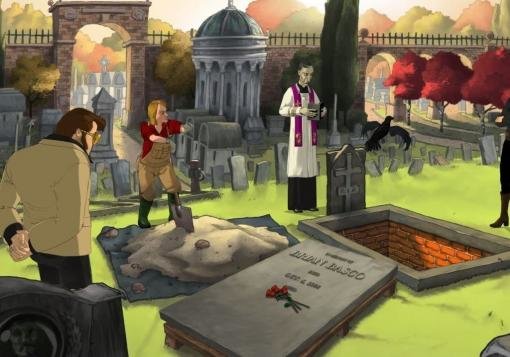
The first two Runaway installments earned many fans due to their slick cartoon art, comedic road-trip storylines, and catchy techno/pop soundtracks, but niggling gameplay issues prevented them from realizing their true potential. Not so with 2009’s A Twist of Fate, which closed out the trilogy with equally high production values and improved gameplay to match. With striking hand-painted artwork, Pendulo Studios delivered a host of colourful, stylized locations, distinct character designs, and TV-quality cinematics. The finale’s in media res storyline is creatively told, and with chapters alternating between the past and the present, has strong momentum and narrative flow.
In a series first, control alternates between feisty ex-stripper Gina Timmins and her boyfriend Brian Basco, who has apparently gone off the deep end thanks to the increasingly ridiculous events he endured in the previous games. The tongue-in-cheek, fourth-wall-breaking humour afforded by this premise makes Runaway’s often unbelievable scenarios much easier to swallow, while its sardonic tone pokes fun at many genre conventions we’ve come to accept but (let’s face it) don’t make a whole lot of sense. Brian’s incarceration in a mental institution, along with the series’ inherent wackiness, combine to make for unusual, outside-the-box puzzles, and the welcome additions of a hint system and hotspot finder mean you’re less likely to be stumped by pixel hunts or nonsensical puzzles. Overall, Runaway: A Twist of Fate is a solidly entertaining experience that puts its own spin on traditional adventure gameplay, and it wraps up a popular but uneven trilogy on a high note.
You might also like: Runaway: A Road Adventure and Runaway: Dream of the Turtle
#96 – Gold Rush!
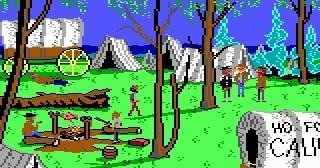
Usually we play adventures because they have a great story or offer challenging puzzles – preferably a combination of both. But some we play as much for their appealing interactive settings and detailed research that can teach us about a certain period, a particular event, or a distinctive culture more than any dry history book ever could, all the while entertaining us as the lead character in our own adventure. “Edutainment” may be a dirty word these days, but that wasn’t always the case, as Sierra’s 1988 Gold Rush! is just such a game. Sure, like many games of its day it's full of dead-ends and the gameplay can be incredibly unforgiving, but as you follow the heartwarming journey of Brooklyn newspaperman Jerrod Wilson in his cross-country trip across America, you can't help but have a good time discovering a mine full of secrets and interesting facts about the real California Gold Rush of 1848.
From the moment the game starts, virtually everything you see can lead to a comprehensive description about nineteenth century customs, and when given the choice of three distinct paths to reach California (in-land stagecoach, ship through Panama or ship around Cape Horn), the amount of evident research that went into detailing the life conditions of the time is simply staggering. It certainly helps that, if you're willing to forgive its now-antiquated graphics and some repetitive gold-panning sequences to reach the grand finale, it’s also a lot of fun to play. Especially when creative use of the text parser is involved, like when Jerrod has to figure out a way to prevent a carriage from tumbling down a slope. It's this ability to strike just the right balance between learning and enjoyment that earns Gold Rush! its place among the all-time genre gems.
You might also like: Dr. Brain series, Cryo historical adventures (Jerusalem, Versailles, Crusaders, etc.)
Next up: #95-91...
#95 – Ripley's Believe it or Not!: The Riddle of Master Lu

Before there was Indiana Jones, there was Robert Ripley. Believe it or not, there might not even be an Indy if not for Ripley, a real-world cartoonist and explorer who travelled the world in the 1930s to report incredible feats on his radio show and collect unique antiquities for his Odditorium museums. The whip- and fedora-clad one may be better known today, even in adventure gaming circles, but Sanctuary Woods’ 1995 Ripley's Believe it or Not!: The Riddle of Master Lu gave the bow-tied, pith-helmeted hero his own chance to shine, and he didn’t disappoint. Although based on the real man, Ripley’s interactive adventure is entirely fictional, sending him around the world in pursuit of information about the tomb of the First Emperor of China, which was built and protected with traps by the ingenious architect Master Lu. Ripley’s not the only one seeking the tomb, however, as it’s said to house the legendary Imperial Seal, an emerald that can bestow mystical powers on whomever possesses it. With enemies ever nipping at his heels, along the way Ripley must also gather oddities to send back home to keep his ailing American museum afloat.
Your travels take you to such exotic locations as China, India, Peru, and Easter Island, which can be visited in any order, even coming and going as you please. Blending live-action characters and nicely pre-rendered backgrounds, each scene is jam-packed with detailed hotspot descriptions, many of them purely optional. The non-linearity and high degree of interactivity make this a fairly difficult game, and there’s some pixel hunting involved in overcoming the many inventory obstacles. Puzzles are cleverly integrated, however, including three timed challenges, such as rescuing Ripley’s friend Feng Li from a king cobra. You can die in this game, as befits the sometimes deadly nature of the opposition, but an auto-save wisely restores to a point just before your demise to try again. All told, The Riddle of Master Lu is a game with everything: diverse locations, engaging characters, and substantial gameplay. But don’t take our word for it: playing is believing.
You might also like: Secret Files series, Flight of the Amazon Queen
#94 – Faust (aka Seven Games of the Soul)
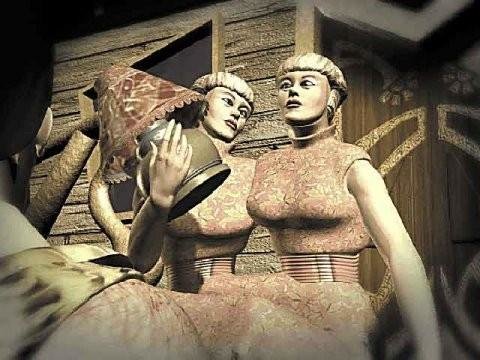
Suicide... Sexuality... Child slavery... Abuse... These aren’t your normal adventure game themes. Then again, Arxel Tribe’s Faust (or Seven Games of the Soul in North America) is anything but your normal adventure game. Exploring many mature, complex psychological themes, the game is loosely based on the 19th century poem by Goethe about a man who sold his soul to the devil. Here Marcellus Faust, an elderly black man, arrives at an abandoned amusement park called Dreamland, where a suave demon named Mephisto tasks him with helping settle a dispute with God. By travelling back in time through seven overlapping episodes, you must investigate the troubled lives of Dreamland’s bizarre inhabitants through their eyes to determine the fate of their souls and unravel the macabre history of the park. From the freakshow exhibits like the Siamese sisters and 550-pound woman to employees like the costume seamstress and tiger tamer, each harbours dark and painful secrets, and it’s up to you to find material evidence that will either implicate or absolve them of complicity with the devil.
Sound deep? It is, and its relentlessly disturbing focus on the seven deadly sins is only scratching the surface. The fragmented storyline is intrinsically multi-layered, offering mystery within mystery, puzzle within puzzle, and subplot within plot as each carnie’s intertwining history slowly weaves together to form a larger picture. The gameplay can be as challenging as the narrative, making this a true thinking gamer's adventure in every respect. The artwork is merely average, but musically the game is a triumph, with a wonderful blend of old jazz, blues, and classical vocals and instrumentals alike, and Mephisto is perfectly voiced as the debonair tempter who genuinely believes in his cause. The bulk of the game is spent raising more questions than it answers, which is what makes it partly intriguing, partly frustrating, but exploring the complexities of the human soul and the ambiguities of good and evil are what give the game its value. It is easily one of the more original adventures available, so play it for yourself if you won't take our word for it, oh ye of little faith.
You might also like: Of Light and Darkness: The Prophecy, Salammbô: Peril in Carthage
#93 – Toonstruck

It may well be remembered as one of the straws that broke the back of the genre's Golden Age, but the commercial failure of Toonstruck has unfairly followed the game around for too long. Burst’s 1996 adventure features Christopher Lloyd as a depressed cartoonist who finds himself sucked into the cartoon world he created. The game, unfortunately, could never recoup its huge budget, but it deserves to be admired on its own merits, not its retail failings. The production values from film industry professionals are incredibly high, displaying quality drawings and animation, and there’s a huge cast of famous voice actors, including Dan Castellaneta of Homer Simpson fame. Compared to other titles at the time, the graphics were top-notch, and sound production was way above the average – no expenses were spared, whether that was a wise move or not.
Although the game makes use of a live-action protagonist inserted into an animated world – an obvious stylistic clash – the writing is so good that you really feel like you have entered a Looney Tunes cartoon, where bizarre logic rules and you have to be aware of comic conventions to solve some of the complex puzzles. The adventure is substantial, too. You complete your main objective halfway through the game, only for the plot to skew off in another direction and unlock a whole new series of locations and characters to find. The story, which plays on the stereotypes created by popular cartoons, is genuinely funny and cleverly combines the sarcastic wit of Lloyd's Drew Blanc (an outsider looking in) with the wacky sense of humour of the toons. The balancing act it walks is very fine, but the script manages to take knowing pot-shots at its influences while still paying homage to the medium that inspired it. A sequel was planned, but the numbers just never added up, leaving only this final reminder of a time when Hollywood, big budgets, and adventure games were once a reality.
You might also like: The Next BIG Thing, Kaptain Brawe: A Brawe New World
#92 – The Dig
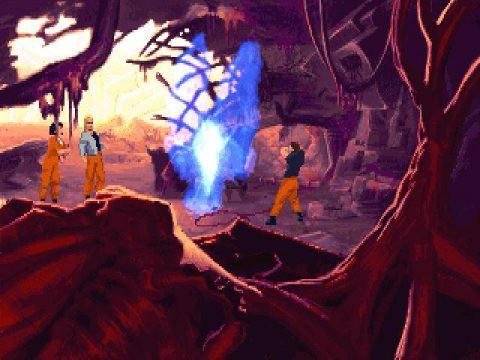
The Dig is often regarded as the runt of the LucasArts litter, never quite resonating the same way as its more famous brethren. Perhaps that’s because it’s a purely dramatic sci-fi adventure and people didn’t know what to make of it back in 1995. And while it’s a traditional point-and-click adventure similar to its comic contemporaries, the game’s puzzle design has more in common with the likes of Myst than any of LucasArts’ other franchises – something that didn’t sit well with all players. Strip away the preconceptions, however, and what’s left is a very good game in its own right, with a mature storyline based on an idea by Steven Spielberg and written by author Orson Scott Card, boasting a stellar production crew with contributions from Industrial Light & Magic.
The story focuses on a group of astronauts tasked with destroying an asteroid, only to be helplessly transported to an alien world in the process. It’s a serious affair that should appeal to sci-fi aficionados thanks to its otherworldly setting and excellent soundtrack, and it wisely (if unexpectedly) avoids any attempts at the developer’s trademark humour. Given its pedigree, it’s no surprise the CGI is flawless, and while the puzzle design is markedly different from the usual zany inventory fare, there are plenty who embrace such mysterious conundrums with open arms. It may never measure up to the widespread appeal of its comedic LucasArts counterparts, but it’s a compelling standalone adventure and a great addition to any serious gamer’s collection.
You might also like: The Immortals of Terra: A Perry Rhodan Adventure, Frederik Pohl's Gateway series
#91 – The Feeble Files
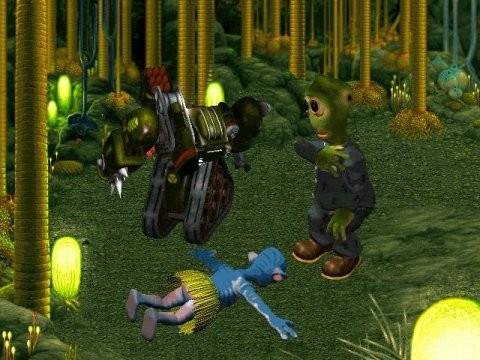
Hell hath no fury like the puzzle designers of The Feeble Files. This offbeat sci-fi adventure should have come with a warning about possible injuries from fist/screen incidents when it was released by AdventureSoft back in 1997. Whether that’s a good thing is for you to decide. Following hot on the heels of Simon the Sorcerer II, this game introduced us to a whole new world of memorable characters. Headlining the case was Feeble, the titular mild-mannered alien lovingly voiced by Red Dwarf’s Robert Llewelyn, who unwittingly embroils himself in corporate espionage and anti-governmental shenanigans after a bad day at the office. An eclectic, entirely non-human cast was a novel take on the point-and-click adventure, and the game represented a step forward in presentation for the acclaimed British developer, while still managing to carry over the humour from the Simon series.
The Feeble Files is a treat for the eyes and ears. Its brilliant mix of pre-rendered backdrops and animated characters look great, it's skillfully acted by some stand-up British comedy talent, and Feeble proves to be a lovable loser-turned-hero that is easy to embrace. However, to truly enjoy this game you’ll need a masochistic bent, as the puzzles have few rivals in their difficulty. They vary from obscure inventory-based tasks to outright horrific minigames and math problems. The Arcade section in particular was so cruel it forced AdventureSoft to release a save file set right after the event so some players could carry on the story. For those who lament the loss of complex, challenging puzzles in the genre, it’s a dream come true. For everyone else… well, there’s always a walkthrough. It’s absolutely worth it, but you’ve been warned. Enjoy immensely at your peril.
You might also like: Rex Nebular and the Comic Gender Bender, The Bizarre Adventures of Woodruff and the Schnibble
Next up: #90-86...
#90 – Spycraft: The Great Game
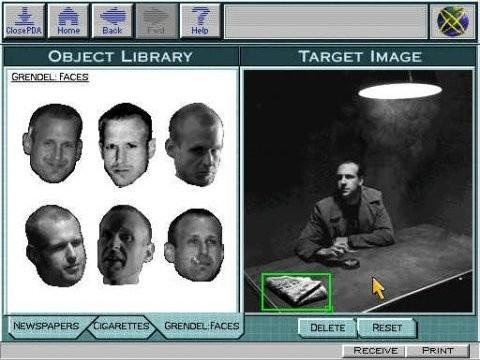
In a medium where spy stories are mostly inspired by the adventures of James Bond, Activision’s Spycraft: The Great Game offers a more traditional take on the espionage genre, where agents do more thinking than shooting and spend more time at a computer than flirting with femme fatales. As a CIA case officer, your mission is to track down a terrorist organization made up of former spies who are planning to assassinate the US president. The result is one of the few games in which FMV really, really works, featuring well-written dialogue performed by professional actors. The authenticity of the story is further enhanced by the input of a former CIA member and former KGB operative, both of whom make cameo appearances in the game.
Despite not being a 007 game there is a gunfight or two, but the somewhat simplistic fights take a back seat to the puzzles, which are in a category all their own. Trace a bullet trajectory back to its origin to catch a glimpse of an assassin’s face. Doctor a fake photograph to convince a prisoner you’ve captured her boyfriend. Isolate ambient sound effects in the background of a phone conversation to pinpoint where the caller was phoning from. The list goes on. Almost every puzzle is unique; completely different from the challenges of most other adventure games made before or since. And because most of the puzzles take place on your avatar’s computer interface, it’s easy to feel fully immersed in the game, as if YOU are the CIA agent sitting in an office at Langley trying to research and track down enemy spies. While other games simply recycle formulas from the past, this 1996 spy thriller stands on its own as an adventure completely unlike any other.
You might also like: Traitors Gate, The Messenger
#89 – The Journeyman Project 2: Buried in Time
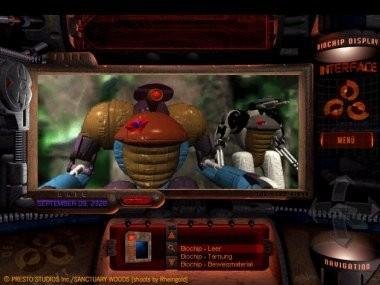
A man being accused of a crime he didn’t commit and trying to prove his innocence is a staple of thriller fiction. Far less common in Presto Studio’s 1995 The Journeyman Project: Buried in Time, the accused man and the one trying to prove his innocence are separate versions of the same man, as time agent Gage Blackwood enlists his younger self to investigate. As in the first game of the series, players end up time-hopping, though now you can travel into our own history as well as the future history of the 2318 setting. Hunting around the lovingly rendered historical settings, from a Mayan pyramid to a besieged castle in medieval France to a studio of Leonardo da Vinci, adds to the fun of time travel, even if direct contact with the inhabitants is still forbidden. The truth behind the events leading to Gage’s arrest build into a solid story with a dramatic conclusion.
For all that, there is one thing that everyone who has played this game will remember most: the artificial intelligence known as Arthur. Once you have found him, Arthur integrates himself into your suit and serves as a companion for your journey. It would have been all too easy to become irritating, but a combination of good casting and well-written, witty dialogue make him a joy to have around. With a love of 20th century culture, his banter is full of clever references and parodies of the player’s own era. Arthur is also much more than a comedy sidekick. His complex computer brain and database storage help him serve as both a hint system and a reference for your historical adventures. Add in a slick soundtrack, and this is one adventure that definitely shouldn’t stay buried in the past.
You might also like: The Journeyman Project Turbo, The Arrival
#88 – Simon the Sorcerer II: The Lion, the Wizard and the Wardrobe

After the success of Simon the Sorcerer, it was only a matter of time before AdventureSoft took us on another trip in the magic closet. Sure enough, two years later we were treated to The Lion, the Wizard and the Wardrobe. In a lot of ways, Simon the Sorcerer II is a far more accomplished game than its predecessor. The setting was drastically expanded, as Simon’s adventure branches to all sorts of locations: cities, dungeons and steampunk castles are all there to be explored. A wider cast of characters was incorporated, like Goldilocks, Um Bongo and the three witches, plus many returning favourites like the swampling. The humour is even sharper as well, worked into a story that flows far better than the original – Simon has much clearer directives than stumbling from one scenario to another on his quest to rid the world of the evil Sordid again.
For all its enhancements, the sequel wisely didn’t reinvent what had been so successful the first time, retaining a similar high quality cartoon look and sound. Unfortunately, this also translated to some questionable puzzle design, which again met with mixed reactions for its obscurity. Simon himself underwent some changes – such a blatantly abrasive character took a lot of getting used to in the first game, and took even more the second time around. The dialogue is still well written, but a new voiceover gave birth to an even more snide delivery of the lines that didn’t sit well with all gamers. Thankfully, the diverse supporting characters proved more than capable of elevating the script to a more palatable level, ensuring that Simon II is generally a hoot to play through, foibles be damned.
You might also like: The Legend of Kyrandia series
#87 – Penumbra: Black Plague
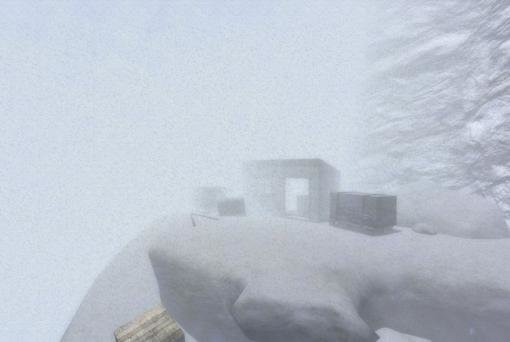
In science, a penumbra refers to the softer, hazy region around the edge of a shadow. But in Penumbra: Black Plague, Swedish horror specialists Frictional Games brought their emerging formula sharply into focus. Rejoining the hero from Penumbra: Overture, the improved sequel charts Philip’s quest through an abandoned Antarctic research base in search of his father. Of course, being a horror title, he's far from being alone, but Black Plague wisely ditched the clumsy combat from the first installment in favour of a powerless Philip running away or hiding from threats. Being defenseless makes for an intensely terrifying, anxious experience that is guaranteed to raise your pulse without requiring twitch reflexes to succeed.
In the puzzle department, Black Plague didn't disappoint either, using a realistic physics engine for some ingenious but natural environmental conundrums. The game is played in first-person and controlled like a shooter, so even simply searching for items feels like a more tactile, engrossing experience than simple pixel hunting. The gameplay and story work well together, but top billing nevertheless goes to the astonishing atmosphere behind them – behind, above, around, everywhere. “Immersiveness” is an overused word when it comes to games, but here it really does apply. The you-are-there perspective, the dark, stylish graphics, and the unnerving audio help create a horror experience that's a dream – or maybe a nightmare – for fans of scary adventuring.
You might also like: Penumbra: Overture, Darkness Within series
#86 – Dark Fall
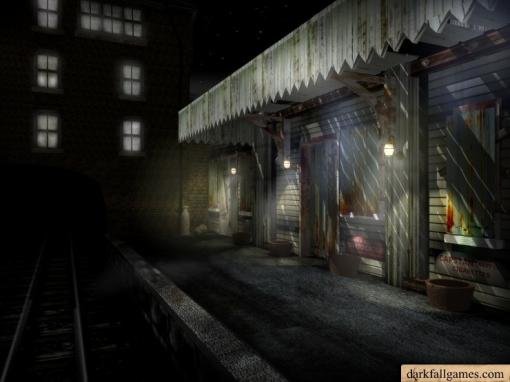
It’s a rare designer who is instantly recognizable by name, but Jonathan Boakes is just such a man. Before 2002, he was a complete unknown in the industry, but that all changed with the release of Dark Fall. Self-financed, created largely on his own, and originally self-published, Boakes’s debut supernatural mystery sent players alone into an abandoned English hotel and train station, where people have been disappearing for decades. Except you’re not alone at all, as restless spirits of those who vanished on the premises still linger there, seeking help defeating the undefined darkness that took them. Though the ghosts themselves are benevolent, the game is still dripping with eerie atmosphere. The phone in reception rings with messages from the other side whenever you walk in. Light orbs zoom through the halls as the lights blink out. There are constant reminders that something is out there in the darkness, watching, though you may never see what it is.
The Dowerton train station and hotel are like characters of their own, reflecting the many different time periods they have seen, from WWII posters plastered in the bathrooms to high-tech ghost-hunting gadgets left behind by the most recent victims. Each room reflects the personality of its final occupant, and the events surrounding their disappearances are glimpsed through the many journals and letters lying around. The sound is superb, from the creak of stairs to the sporadic whispers around you, and the many puzzles fit well into the story, several of which require observant note-taking elsewhere to solve. It’s a little rough around the edges and clearly a low-budget endeavour, but the craftsmanship that went into this self-proclaimed “labour of love” is abundantly evident. Not long after its enthusiastic reception, it was snatched up by a publisher and subtitled The Journal, and the series has since gone on to inspire not only two sequels by Boakes, but numerous other indie horrors as well. Dark Fall is an impressive achievement for one man, and its legacy demands its inclusion on the list.
You might also like: Dark Fall: Lights Out and Dark Fall: Lost Souls, The Lost Crown: A Ghost-hunting Adventure
Next up: #85-81...
#85 – The Dark Eye
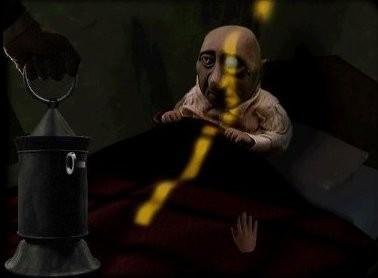
Expectations are a dangerous thing. InSCAPE’s surreal 1995 The Dark Eye was originally released to mediocre reviews and frustrated gamers who didn’t know what to make of it. It’s so much easier to appreciate now, experiencing it not so much as an adventure game as an art installation – a thoughtful fever dream that stands as an utterly unique companion to the works of Edgar Allan Poe. It’s a game about exploring (and getting chills from doing so) rather than conquering. An eerie, empty mansion sets the stage for three of Poe’s stories to come to nightmarish life, each populated by stop-motion puppets with jerky movements, ornate clothing, and cold eyes of clay. The scenery is bleak and unwelcoming, and the situations you find yourself in are equally unnerving as you ask yourself: How do I make it through this story, knowing it doesn’t have a happy ending? The vignettes can be completed twice each as both victim and perpetrator, offering a disturbing dual perspective of the same tragic scenarios.
Like the most compelling dreams, you can’t exactly trust where the game’s going, particularly if you aren’t familiar with Poe’s original works. Still, the accounts are beautifully told, the soundtrack by Thomas Dolby is richly atmospheric, and the voice acting is wonderful done (William S. Burroughs plays the house's owner, as well as providing readings of Poe's "Masque of the Red Death" and "Annabel Lee"). There are wonderful twists of narrative, portions where the standard first-person view is warped by visual oddities, and places where the standard interface is turned on its head to better serve the story. Much like the works of Edgar Allen Poe himself, the sum total is a collection of stunningly beautiful but frighteningly macabre tales. It certainly isn’t cohesive. It’s hardly even an adventure game. But for its ability to immerse you in the twisted, horrific visions of its esteemed author, The Dark Eye does just about everything right.
You might also like: Bad Day on the Midway, Gadget: Past as Future
#84 – Colonel's Bequest: A Laura Bow Mystery
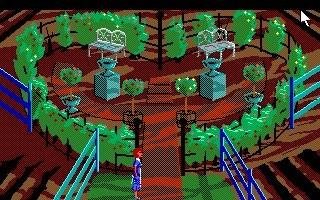
After reinventing the interactive fairy tale with King’s Quest, legendary designer Roberta Williams turned her attention to a new type of game with Sierra’s 1989 mystery adventure The Colonel’s Bequest. The story centers around 1920s-era Louisiana and young journalism student Laura Bow, who is invited by her flapper friend Lillian to visit her family’s plantation island – but all is not well when the Colonel’s will is read, and what starts as simple family bickering soon leads to murder. Of course, Lillian’s family is a cast of scoundrels and reprobates who cheat, lie, and steal, and thankfully reveal as much in conversations that can be spied on by the intrepid Laura. Like a classic Agatha Christie whodunit, one murder leads to another and discovering secrets becomes secondary to staying alive.
The Colonel’s Bequest displays a remarkable commitment to its time period, as the art deco, flapper dialogue, and vintage wardrobes all show reverence to the Roaring ‘20s. Similarly, the deviant and nefarious behavior of the rogues’ plantation host is perfectly suited to this type of murder mystery, and Williams writes it with flair and enthusiasm. The game shows incredible attention to detail in trailing the actions of the characters, and even features remarkable replay value, as the ending gives you an indication of all the secrets you did not learn (which will be many on the first playthrough). Along with its slightly-less successful sequel, The Dagger of Amon Ra, this game established Laura Bow as an adventure heroine whose time came and went too quickly.
You might also like: The Daggor of Amon Ra, Agatha Christie series
#83 – The Black Mirror
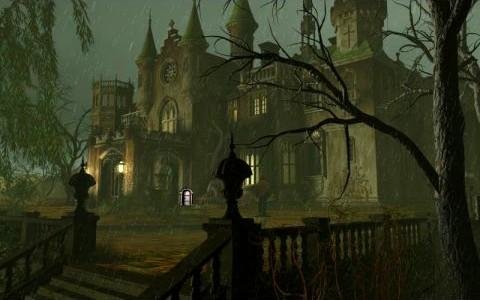
Coming virtually out of nowhere from the aptly named (at the time) Unknown Identity, The Black Mirror became a cult hit when it arrived in 2003. With its grisly subject matter and relentlessly dark atmosphere, the game oozed tension and delivered plenty of perverse thrills, including your own death in disgusting fashion over and over again. It also ended with one of the most shocking finales of all time, which seemed to bring full closure to the saga of the Gordon family curse, though its surprise popularity ensured a pair of sequels would come nearly a decade later. Both are probably better, more polished games than the original, but for laying the bloody groundwork in such compelling fashion, the first will always be the most memorable.
With its gorgeous pre-rendered backgrounds, The Black Mirror paints a vivid, if grim, picture of the Black Mirror manor and the quaint, slightly sinister English village of Willow Creek. The game chronicles the story of Samuel Gordon, a man haunted by an evil force that has attached itself to his ancestors and has now passed down to him. The tale takes time to build up the horror and insanity that Samuel must eventually confront, during which time you’ll spend a large amount of time hunting for inventory items and speaking with distinctive characters like the sleazy pawn shop owner and the strange doctor working in the town’s morgue. Its appeal is tainted somewhat by wooden voice acting and a protagonist that can rub people the wrong way, but even with all the rough edges, this game carved out an unforgettable legacy that kept people clamouring for more even years after its release.
You might also like: Black Mirror II and III
#82 – The 7th Guest

“Welcome to my… house.” In 1993, psychopathic toymaker Henry Stauf invited players to his creepy mansion for a night of intrigue, puzzle solving, and murder in Trilobyte’s The 7th Guest. A new type of adventure at the time, the game lacked an inventory, dialogue options, or even a visible player character; its gameplay was entirely comprised of standalone logic puzzles, brainteasers, chessboards, and mazes. With one or two puzzles hidden in each of the mansion’s many rooms, the objective is simply to gradually gain access to the entire house and solve them all. Meanwhile, the grisly fates of Stauf’s other unfortunate dinner guests are revealed via full-motion video scenes that flicker in and out over the 3D environmental art.
These days the graphics are passé, the acting beyond cheesy, and the puzzles very familiar—all factors that make The 7th Guest easy to dismiss. But compared to what was on the market at the time, it was a bold vision of the future of gaming, and its many innovations helped secure its spot here. As the first computer game to ship exclusively on CDs, The 7th Guest played an important part (along with Myst) in ushering in the rapid adoption of CD-ROM drives. Its groundbreaking use of live actors, at a time when few adventure games even had voice acting, also opened the floodgates for a torrent of FMV adventure games in the years that followed. And nearly two decades later, its puzzle-based format lives on in series like Professor Layton. Its own success may have been short-lived, but it left an indelible mark on the genre all the same.
You might also like: The 11th Hour, Clandestiny
#81 – Quest for Glory II: Trial by Fire
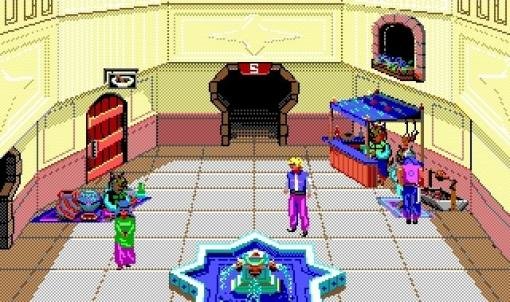
When Hero's Quest (later renamed Quest for Glory: So You Want To Be A Hero?) came out, its skillful blending of traditional adventure gameplay and RPG elements was, if not unprecedented, certainly original and refreshing in its presentation. The second game in the series, Trial by Fire, took that formula and improved it in every single respect in 1990, starting with a setting and story that moved away from the usual fantasy tropes to embrace Arabian culture and mythology. This proved to be the right choice, because even decades after the game’s release, its backdrop inspires a distinct sense of wonder and discovery. Sierra also made refinements to the combat system to make it more responsive and challenging. But fret not: even if you don't like action in your adventures, the battles are almost always optional and the game is literally packed with other features any adventurer will enjoy.
For starters, there’s the option to import your character from the previous game and see him continue to grow throughout the sequel, creating a sense of ongoing attachment few adventures have managed before or since. Dozens of little nods to the first title enhance this feeling of continuity, and by the end of the game your newly-crowned Prince of Shapeir will certainly have claimed a permanent spot in your adventurer's heart. This time around, each playable class (Fighter, Wizard and Thief) gets something special out of the adventure, whether the Wizards' Institute of Technocery, the Eternal Order of Fighters or even stealing the famous Maltese Falcon. And if that isn’t enough, there are tons of tough puzzles, optional activities that help shape your character the way you want, a cast of endearing characters, and a game world that feels vividly alive and coherent. When you add everything up, it’s not hard to see why Trial by Fire is a definite step up from its predecessor and a must-play for every would-be Hero.
You might also like: Superhero League of Hoboken, Shannara
Next up: #80-76...
#80 – Sherlock Holmes: The Awakened
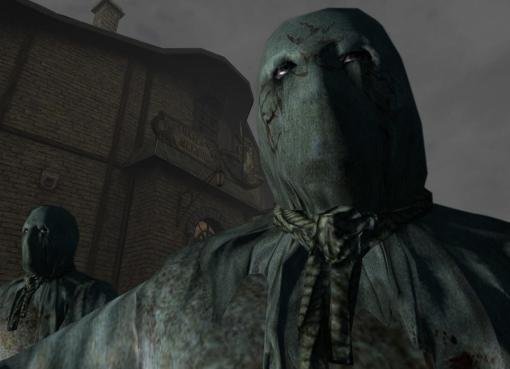
With a couple Sherlock Holmes games already under its belt, Frogwares finally found the winning formula in 2006 with The Awakened. A melding of Sir Arthur Conan Doyle’s famous detective and H.P. Lovecraft’s Cthulhu mythos, the game puts Holmes and Watson on the trail of a cult who have kidnapped various people for use in one of their dark rituals. Ever the realist, Sherlock may not believe in the supernatural, but the cult poses a legitimate threat, so it’s up to him to stop them from killing more innocent people. His search leads him all across the world, from an asylum in Switzerland to a steamboat in New Orleans, giving the game a welcome scope. It's all presented in free-roaming 3D, making this one of the rare adventures of its time to modernize the genre with current technology. Ironically, a later “remastered” version offered the option to switch the game to a more traditional third-person, point-and-click adventure, making it far and away the most user-adaptable adventure of all time.
While the influence of Lovecraft is fairly minimal in anything other than name, The Awakened is nevertheless committed to its dark horror themes. With plenty of blood, dead bodies, and evidence of evil practices, the game does an excellent job of creating a creepy, ominous atmosphere. Though the animations leave something to be desired, the character designs and voice acting go a long way to bringing the iconic characters of Holmes and Watson to life. There’s lots for them to do as well, with crime scenes to investigate with Sherlock’s signature magnifying glass, lab work to perform at 221b Baker Street, and numerous puzzles to solve, including quiz questions that must be correctly answered, creating a varied and well-rounded adventure experience. There have been several cross-franchise mysteries since The Awakened, each further refining the visuals and pushing the series’ technology forward, but they all owe a great deal to the progressive design overhaul established here. It was this game that made the great detective relevant again to a new generation of gamers, and for that it earns its place among the genre’s best.
You might also like: Sherlock Holmes: Nemesis, Sherlock Holmes vs. Jack the Ripper
#79 – Gemini Rue
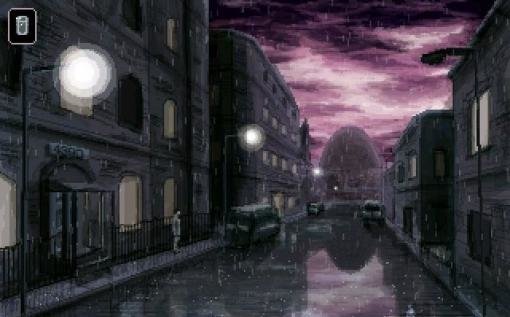
The impressive Gemini Rue is a 2011 neo-noir science fiction tale with an incredible human element and a mind-blowing plot twist in the third act, but it’s also a stirring example of how one young game designer’s dream can find great success in reinventing the classic Golden Age adventure. UCLA Media Arts student Joshua Nuernberger likely couldn’t have imagined when he entered Gemini Rue into the 2010 Independent Games Festival that just one year later it would be recognized as one of the greatest adventures in the modern era. But that’s exactly what happened, and it’s all done in a very nostalgia-friendly retro format, complete with a classic Sierra-style interface, 320x200 backgrounds and relatively confined areas with mostly simple puzzles.
The story is the game’s most outstanding feature, telling the parallel tales of Azriel Odin, a rogue police officer with a dark past searching for a close friend who has disappeared; and Delta-Six, a resident of the mysterious Center 7 facility who, as part of a rehabilitation process, has had his memory wiped and is undergoing weapons training. While seemingly disconnected at first, their fates are destined to collide in dramatic and dark fashion in the game's final hours in one of the better story twists that any adventure game has ever featured. The game even implements some gentle action scenes to bump up the intensity of the gunfights. But it's the emotional weight in its storytelling that makes this game a must-play for any fan of neo-noir stories, or retro-style adventures, and within its bleak and impactful story, it points the way to a very bright future for independently developed adventures.
You might also like: Rise of the Dragon, Snatcher
#78 – Freddy Pharkas: Frontier Pharmacist
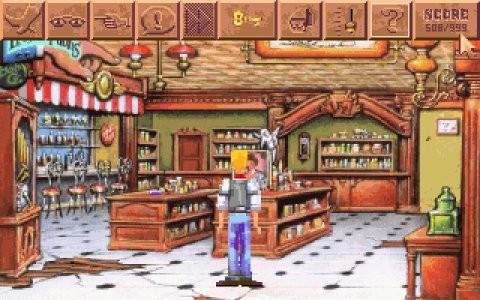
Spoofs are always fun, especially if you're a fan of the genre they mock. And if you happen to be a Western buff who can hum the theme to The Good, the Bad and the Ugly by heart, Freddy Pharkas: Frontier Pharmacist is definitely the game for you. Co-written by Josh Mandel and Al Lowe, the latter of Leisure Suit Larry fame, this little Wild West gem trades the raunchy jokes of that series for tons of tongue-in-cheek puns that satirize every major cliché of the Western genre. Midday duels with blazing guns? Check. Moustache-twirling villain who manages to make fun of Sierra's president? Check. Crowded saloon full of prospectors, gamblers, cowboys and prostitutes? Check. And the list goes on. Mel Brooks would be proud.
But there's so much more. Underneath the layers of humour is a pretty solid adventure in its own right, with inventive puzzles, entertaining characters (including Srini, Freddy's Indian helper, who is one of the greatest sidekicks ever created), outstanding production values and a script that will both amuse you and fill you with genuine appreciation for a truly fascinating period of American history. You’ll get the chance to employ your pharmaceutical skills with help from the hilarious instruction manual/reference guide. And let’s not forget the jaw-dropping final twist that you can't possibly see coming, which is absolutely guaranteed to put a large smile on your face. The game is difficult, and perhaps a bit too unforgiving at times, but Freddy Pharkas is worth the effort. It’s a fun time for all, and if you haven’t yet played it for yourself, go ahead and give it a shot. Just don’t blow your ear off.
You might also like: Wanted: A Wild Western Adventure (aka Fenimore Fillmore: The Westerner), Al Emmo and the Lost Dutchman’s Mine
#77 – Silent Hill: Shattered Memories
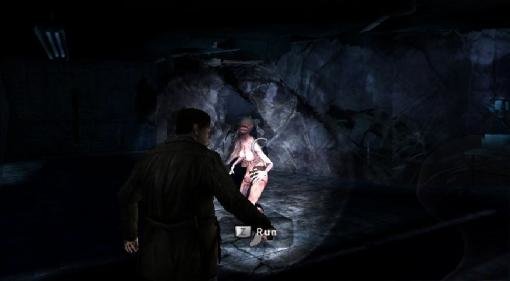
The original Silent Hill, released in 1999 for the PlayStation, helped cement the blueprint for the burgeoning survival horror genre – tight corridors, scarce ammo and health, pervasive darkness, and nonsensical puzzles. Each successive game hewed close to the same formula, until American developer Climax Studios decided to mix things up with a reimagining of the original game, sans combat. When Harry Mason wakes up from a car crash just outside the quiet resort town of Silent Hill, his daughter Cheryl is missing. Setting out to find her, he ends up meeting some of the town’s off-kilter residents, fending off surreal, horrific creatures, and exploring nightmarish mirror-versions of the town. It’s a less splatter-happy, quieter and more psychological adventure than the original, and the lack of combat encourages more exploration than its more frantic predecessors, making for a welcome change of pace and direction for the series.
Silent Hill’s initially mundane town locations feel all the creepier because of how familiar they seem. Who expects freakish horrors to lurk in an elementary school or mall? The town looks and feels like a real place, and the play of light and shadow makes even walking around feel tense and enjoyable. Characters feel similarly real and have complex personalities and motivations that go beyond typical NPCs, brought to life with excellent animation and voice acting. The distinct “Nightmare” sequences, during which Harry has to flee and hide from the grotesque monsters inhabiting the city, are occasionally frustrating but add a definite jolt of terrifying adrenaline to the gloriously creepy, Lynch-ian atmosphere of the rest of the game. You'll want to push beyond your fears to discover the secrets hidden both in the city and in Harry himself in this deep, intriguing character study that plumbs the effects of psychological trauma with haunting truth. There’s more action than a traditional adventure, but far less than traditional survival horrors. Whatever you call it, Silent Hill: Shattered Memories manages to be one of the best games in one of most acclaimed franchises ever, earning it a deserving spot on our list.
You might also like: Echo Night: Beyond, Inherent Evil
#76 – Drawn: The Painted Tower

You may think casual games are all about crazy locking puzzles, hidden object scenes, and generic storylines, but in 2009 Big Fish Games proved that notion completely wrong by releasing Drawn: The Painted Tower. There are no hidden object scenes in this breathtaking “lite” adventure, where you attempt to save a young girl who has the ability to create living works of art. The gorgeous hand-painted fantasy backgrounds, off-kilter architecture and vibrant use of colors are inspired. The majority of the game takes place in a dusky, tarnished tower, where blue and grey hues make for a sombre and subdued atmosphere that explodes into bursts of brilliant red and luxuriant green, warm yellow and peaceful azure as soon as you step directly into a painting. These paintings create windows into picturesque worlds full of enchanted trees, talking scarecrows, quirky witch doctors, and fire-breathing dragons.
The game also takes its “Drawn” title seriously; when you pick up a piece of chalk, you’re not just acquiring a simple inventory item; you’ll use that chalk to actually draw changes in your environment, such as altering a scene to make it rain. These drawing challenges are interspersed with more traditional inventory puzzles and logic puzzles that are gloriously integrated and wonderful to look at. A mechanical clockwork, as merely one of many imaginative examples, is a highly detailed painted wood cutout where you have to match the correct weapon against the appropriate beast. All this and a powerful musical score make this game a giant artistic leap forward in the world of casual adventuring. It has since spawned two additional sequels that have arguably outshone their predecessor, but Drawn: The Painted Tower was the first to lay its bold brushstrokes to canvas.
You might also like: Drawn: Dark Flight and Drawn: Trail of Shadows
Next up: #75-71...
#75 – King’s Quest: Quest for the Crown

In the early eighties, a young company named Sierra On-Line took a chance with a brand new type of game that introduced animated “3D” graphics to the already-popular text adventure format. Created by Roberta Williams, the game was King’s Quest: Quest for the Crown, and at the time there was nothing else like it. As in a text adventure, players communicated with the game by typing in two-word commands, but King’s Quest’s 16-color graphics created a full visual world where before there had only been words. Using the arrow keys, players could move the protagonist Sir Graham across the screen, behind rocks and in front of trees. The unassuming hero with the feathered cap could jump, swim, and tumble to his death. And, with skillful input from the player, he could recover the three lost treasures of Daventry and become king.
By modern standards, the first King’s Quest is incredibly simplistic. Its storyline is little more than a mish-mash of fairy tale themes and its gameplay is riddled with dead-end scenarios and potential fatalities. But even if the pixelated graphics, finicky text parser, and often-frustrating gameplay haven’t aged gracefully, Quest for the Crown will forever be remembered as groundbreaking for its time. Its success jumpstarted the graphic adventure genre and paved the way for Sierra’s industry dominance in the eighties and nineties. Its historical importance has secured a spot on this all-time classic list, though it’s from a historical perspective that King’s Quest I is best enjoyed today – not necessarily as an adventure gaming masterpiece, but as a glimpse at how it all began.
You might also like: King’s Quest II: Romancing the Throne and King’s Quest III: To Heir is Human
#74 – Shadow of the Comet

The work of H.P. Lovecraft has inspired a myriad of novels, movies and games over the years. One of the most frightening, Shadow of the Comet, perhaps captures the eerie atmosphere of such tales as The Dunwich Horror and The Shadow over Innsmouth more effectively than all of them. As photographer and journalist John Parker, you are called to a secluded New England town to do a report on Halley's Comet, but you'll soon find yourself investigating the strange events that occurred there during its previous passage in 1834, when an astronomer came to the village and went mysteriously insane. The original interface of this 1993 Infogrames adventure is quite cumbersome by today’s standards (at least before being updated in a CD-ROM re-release), making segments requiring quick reflexes incredibly taxing, and some solutions like the infamous Icarus-like escape device are a bit silly, but the otherwise gripping story and fear-filled atmosphere are what make this adventure an unheralded classic that every horror fan should play.
Like any good Lovecraft adventure, when you walk through the early twentieth century streets of Illsmouth, even in the comforting light of day, the atmosphere is so thick and ominous that you constantly feel that something bad is about to happen. The unnerving, disquieting soundtrack feeds this tension beautifully, reinforcing the sense that every corner you turn may conceal one of the unspeakable horrors of the Cthulhu mythos, putting a constant strain on your nerves. The horror isn’t merely implied though, by any means. Something ancient lurks beneath the town, waiting to be reawakened, and you better hope it’s not you. Some sequences, particularly toward the end of the game, are definitely not for the faint of heart and are bound to send a thrilling shiver down your spine. If you're looking for an adventure capable of keeping you on the edge of your seat and then making you jump from it, you still can't go wrong with Shadow of the Comet, even to this day.
You might also like: Prisoner of Ice, Phantasmagoria
#73 – Discworld II

It may not have the most cohesive story or the best puzzles of all the adventures on this list, but boy is Discworld II fun. In 1996, Rincewind and his walking luggage trunk were back for yet another round of acerbic British humour, and the young wizard looked awfully good delivering it. A year after the original game brought Terry Pratchett’s imaginative world to PCs, the sequel arrived sporting some pretty standout cartoon graphics. It was a beast to run due to its lavish backdrops and detailed animation, but now that the hardware has caught up (and far surpassed it), the vivid art design still hold up well today. Better yet, this fantastical world is full of interesting sights to see and oddball characters to meet, from the dwarf lothario with a stepladder to Uri Djeller and his strenuous spoons. The Discworld is a fun place just to be.
In this adventure (subtitled Missing Presumed…!? or Mortality Bytes! depending on where you live), the young Rincewind has to travel the Disc in search of Death, who’s decided it’s time for a holiday. The puzzles marked a vast improvement over its predecessor’s unrelenting difficulty, making far more sense (as much as anything on this world can) in the context of the game, resulting in a much more enjoyable romp. The standout comedy cast returned, with Monty Python’s Eric Idle reprising his lead role. Discworld II is a consistently funny game that knowingly pokes fun at the genre throughout. Not a line seems to goes by without some reference to the decline of adventure games or conventional inventory puzzles. Ironically, it did nothing to remedy these criticisms itself, but its self-deprecating humour went a long way in lifting the game above its less successful contemporaries.
You might also like: Discworld, Time, Gentlemen, Please!
#72 – Maniac Mansion
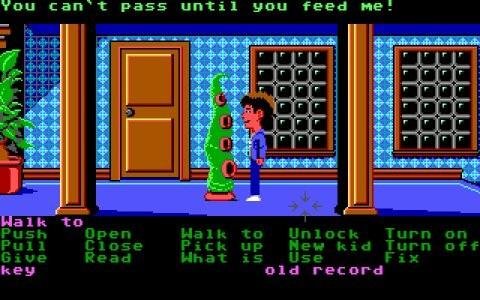
Before there was Monkey Island, there was Maniac Mansion. In fact, if not for the first adventure designed by Ron Gilbert (along with Gary Winnick), who knows how the adventure genre might have evolved. It’s so old now that many gamers may never have played this 1987 title, but it was that important in its day. Produced by Lucasfilm Games (now LucasArts), Maniac Mansion was the first true point-and-click adventure released, pioneering the verb-based SCUMM engine used to power so many of the company’s classic games to follow. The game was much different than its story- and character-driven successors, instead thrusting you into multiple roles on a simple rescue mission, with a choice of protagonists and an open, non-linear means of achieving your goals.
Twenty years after a large and ominous meteor crash landed on the family lawn of the Edison family, the mansion is now home to bizarre and murderous experiments. Dave Miller suspects that his cheerleader girlfriend has been kidnapped by Dr. Fred and sets out with two of his chosen friends to find her. After picking two friends to accompany Dave (from six choices), you can switch between your three playable characters at any time in order to use each person's skills to solve puzzles in a number of different ways. Some are more mechanically inclined, while others are strong, more artistic, and so on. The simple premise never involves any more than getting into the house, finding Sandy, and trying to thwart the plans of the evil scientist and his equally deranged family. As one of the earliest LucasArts adventures, Maniac Mansion includes some deaths and dead ends, but its open-ended gameplay and quirky, B-grade horror film parody humour ensure it retains much of its original entertainment value today, quite apart from its significant historical contributions to the genre.
You might also like: Zak McKracken and the Alien Mindbenders
#71 – Leisure Suit Larry: Love for Sail!

Leisure Suit Larry became an iconic figure in comic adventure circles in the late ‘80s and ‘90s, though the lovable-but-ever-unlucky loser didn’t truly come into his own (so to speak) for the modern era until 1997’s Love for Sail! It’s certainly debatable which game in the series was the best in its time, but the final adventure designed by Al Lowe for Sierra is the only one that really holds up well to this day. This is due mainly to its technical refinements, but its witty and somewhat bawdy humor, clever puzzle implementation, and colorful cartoon graphics have lost none of their original appeal. This time out, Larry finds himself on a luxury love boat trying to win a date with the vivacious Captain Thygh. Unfortunately for Larry, it’s a test of masculinity, a resource in very short supply, so he’ll have to use his big brain to solve tricky puzzles and cheat his way into the captain's bed.
Like its predecessors, Leisure Suit Larry 7 is an unashamedly “adult” game with a Benny Hill-style of humour full of sexual innuendo and risqué scenarios. The interface included a few enhancements over earlier iterations, however, with a fully interactive map to help you get around the PMS Bouncy and a rather distinctively-shaped smart cursor, which brought up a small verb menu that even allowed typing particular commands. Other fun gimmicks were added as well, like a Scratch-'n'-Sniff card and an ongoing “Where’s Dildo?” take on the Waldo craze. Leisure Suit Larry is never going to be everyone’s cup of tea, but putting aside any political correctness, the series remains one of the funniest ever. It’s tough to pass over the original game for its special place in history, but for ongoing accessibility and just plain fun, the seventh and final “real” Larry adventure is the most worthy representative for our top 100.
You might also like: Sierra’s Leisure Suit Larry series (especially #4!)
Next up: #70-66...
#70 – Amber: Journey's Beyond

In 1996, a little independent company called Hue Forest Entertainment released an unassuming adventure game called Amber: Journeys Beyond, which remains their only published title. Amber casts players in the first-person role of an unnamed protagonist who, by means of various ghost-hunting equipment scattered throughout a haunted house in North Carolina – including the hi-tech device called the Astral Mobility By Electromagnetic Resonance – must enter the minds of three restless spirits who inhabit the mansion and help them move on. Inspired by Myst, the game was not a commercial success, unfortunately, and it took several years to garner the attention and praise it deserves, and even then its popularity was short-lived, undermined by serious compatibility issues as the years passed. But that takes nothing away from the quality of the game, which set the early standard for the many indie horror developers today.
Each story is told through a different graphic style that instantly conveys the mood related to its particular ghost, from the faded photographs that make up the memory of a woman who died during World War II to the strangely distorted perceptions of a gardener obsessed by UFOs, or the watery images that form a child's sad reminiscences of a distant, snowy winter. Despite an ending that is perhaps a bit too abrupt, Amber’s crisp graphics, polished interface and streamlined but elegant gameplay created a memorable cult classic, capable of capturing the gloomy, sorrowful ambience of the best Victorian ghost stories with rare sophistication. Years before the ghost-hunting adventure became the popular sub-genre it is now, this game showed what a small indie team could achieve in a solitary first-person horror, and to this day it remains perhaps the best of them all.
You might also like: Barrow Hill, Scratches
#69 – I Have No Mouth, and I Must Scream
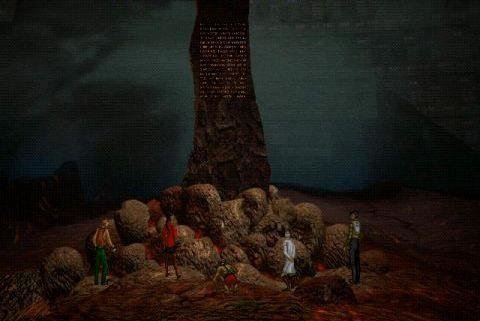
You can use up a lot of appendages counting the number of adventure games classified in some branch of the “horror” genre, including many that are too timid to be genuinely frightening, and others that try so hard with stereotypical “scare” clichés that they wind up as unintentional comedies. However, the number of truly scary psychological horror games can be counted on very few fingers, and one of the greatest is the uncompromising and horrifying 1995 Dreamers Guild adventure I Have No Mouth, and I Must Scream. Based on a short story by Harlan Ellison (who wrote all dialogue for the game despite not owning a personal computer), the game follows the post-apocalyptic quest of five humans, imprisoned and tortured in their own private hell by a sentient super-computer named AM, as they seek to escape and defeat their captor.
If alternating between five characters described as a suicidal loner, a distorted brute, a hysterical phobic, a secretive sadist, and a cynical paranoid doesn’t sound intriguing enough, than perhaps the disturbing imagery of people impaled on meat hooks, or mutilated children in Nazi camps will do the trick. This is an unapologetically twisted game, but one that is well-constructed with an involving and complex narrative, never resorting to cheap scares or contrived horror. While gameplay is traditional, the game features a spiritual barometer that measures good and evil acts, and factors into which of the multiple endings you'll receive. The game is also visually detailed (in all the worst ways for those with weak hearts) and has outstanding voice acting. It may not be a game that anyone would consider “fun”, but if you can handle this type of relentless psychological horror, you will be hard-pressed to find many adventure games that do it as well.
You might also like: Dark Seed series, Downfall
#68 – Shadow of Destiny (aka Shadow of Memories)
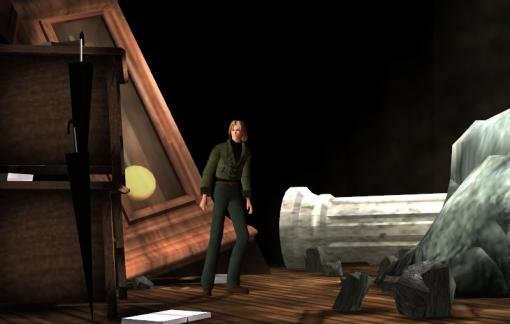
Konami’s Shadow of Destiny opens with a violent death: your own. No, it’s not the shortest adventure game in history, but it’s surely one of the most unusual. Playing as hapless murder target Eike Kusch and armed with a pocket-sized time-travel device, you must stave off successive murder attempts by repeatedly turning back the clock – sometimes by a few minutes, sometimes by a few centuries – with the goal of changing the past in ways that impact the present and thwart the killer. Though it’s a relatively short game in a single playthrough, few adventures offer Shadow of Destiny’s replayability, due to its branching story threads and eight different endings. And even fewer games will leave you mulling over the story’s implications and questioning its true meaning long after you’ve finished, as this one surely does. With each replay you learn more about what’s going on and only after seeing all of the endings will you truly understand this intriguing narrative puzzle.
One of the very few adventures being developed and published by a mainstream game company at the time, Shadow of Destiny (or Shadow of Memories in Europe) is a multi-platform game first released in 2001 for PlayStation 2, then ported to PC, Xbox (only in Europe), and nearly a decade later to PSP. The PC version was poorly marketed and hard to find even when it first came out, which is likely the reason this game is such a little-known gem even among adventure game fans. The blocky 3D graphics are dated now and the awkward keyboard controls can make it challenging to play, but Shadow of Destiny’s unique storyline and clever time-travel gameplay more than make up for any technical shortcomings, earning it a spot on the list and hopefully some long-overdue public attention.
You might also like: Time Hollow, To the Moon
#67 – Pepper's Adventures in Time
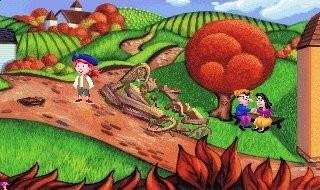
The balance between entertainment and eduboredom has always been an extremely fine line. Among the few adventure games to successfully strike the perfect balance between learning and fun is Sierra's 1993 classic Pepper’s Adventures in Time. It seems crazy Uncle Fred used his time machine to send a little dose of the 1970s to colonial times, and the result is the Liberty Bell being transported around by Hare Krishnas, and a pre-Revolution Ben Franklin telling people to “chill out” while the British governor taxes the people silly. In making sense of all this absurdity, the game features one of the most brilliant devices in modern educational gaming. History has been twisted by the mellowness, but clicking the “Truth bubble” on something tells you whether it really existed in that era. The amount of information contained in those responses is phenomenal, and will appeal to anyone with even a remote interest in American history.
All the while the game is teaching, however, it never stops being an engaging adventure with consistent story development as you attempt to restore the period to the way things were meant to be. It's certainly not difficult by any stretch of the imagination, but there are plenty of puzzles. The colonists all have a great deal of humorous dialogue brilliantly written by Lorelei Shannon, bringing plenty of local flavour to the landscape. And of course, how can you not laugh at the spectacle of a laid-back Ben Franklin? (Until you manage to send lightning through his body, that is.) A promised sequel never materialized, but Pepper’s Adventures in Time proved that when done right, there may be no better way to teach foundational concepts of history than a delightfully simple adventure game.
You might also like: EcoQuest series
#66 – Callahan's Crosstime Saloon
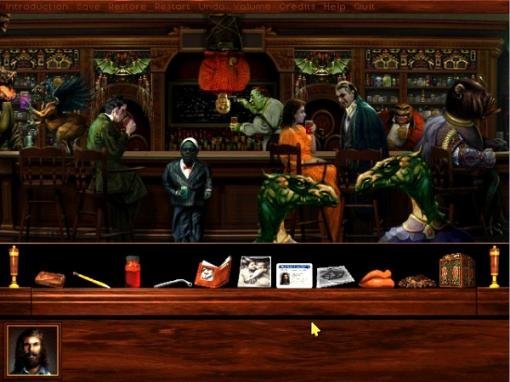
In the eternal LucasArts vs. Sierra debates, Legend Entertainment is often unfairly overlooked, as their games were consistently smart, entertaining, and superbly produced. One of the best examples is 1997’s excellent Callahan's Crosstime Saloon. In this adaptation of Spider Robinson's sci-fi stories about Jake Stonebender and his friends at Callahan's bar, the universe is about to be wiped out unless something can be found that proves it deserves to survive. Naturally, only a down-and-out folk singer who can’t pay off his tab is the one to discover what that is. Before he can do so, however, he’ll need to stop an alien race from sapping the world of testosterone, save an endangered strain of orgasmic Brazilian chocolate from extinction, and rescue a lovesick Transylvanian vampire, among other tasks. They’re as daunting as they are diverse, but for Jake it’s all in a night’s work. And hey, no pressure or anything.
Between quests you return to the cozy confines of the pub to solve word riddles and chat with the witty, pun-loving locals, which adds a delightful sense of camaraderie to the game. The real delight here is the script, including constantly hilarious commentary on absolutely everything, with plenty of interactive opportunities to experience it, much of it simply for fun and flavour. And yet beneath the bizarre objectives and clever comedy, there’s a real underlying depth to Jake’s own life story that perfectly complements the otherwise whimsical tone. So forget Cheers. Callahan’s is the place to be for good friends, flowing drinks, plenty of laughs, and a whole lot of heart. Plus a darn fun adventure to boot!
You might also like: Companions of Xanth
Next up: #65-61...
#65 – Hotel Dusk: Room 215

Cing’s Hotel Dusk: Room 215 became one of the rare modern day adventures to capture the attention of both genre fans and mainstream gamers alike. Billed as an "interactive novel" (presumably to avoid scaring off anyone off with the unflattering term “adventure game”), this 2007 title helped establish the Nintendo DS as a viable platform for text-heavy offerings by taking typical noir themes and turning them into an intimate, personal experience. It’s a very unassuming affair, full of gentle jazz music, light puzzling, lots of low-key dialogue, and a muted graphic novel-style aesthetic, but beneath its cool, mellow tone and relaxed pace is a gripping, complex mystery tale. It’s even held sideways like a good book.
Taking place entirely over the course of one night in 1979, ex-New York cop Kyle Hyde is seeking information about the former partner who betrayed him, and his investigation curiously intersects with the secrets of his ten fellow hotel guests. It’s presented in a unique visual style, featuring expressive hand-sketched black and white characters. Some clever puzzles use the DS to mimic in-game situations, but where this game really shines is in its gradually-unfolding mystery, pieced together by wandering the lonely halls of the hotel, chatting with its eclectic guests, and casually poking about for clues at your leisure. Dialogue-heavy and light on puzzling, Hotel Dusk: Room 215 is comfort gaming for those who love story-driven mysteries, and it remains one of the most memorable examples of modern day interactive fiction, portable or otherwise.
You might also like: Jake Hunter Detective Story: Memories of the Past, 999: Nine Hours, Nine Persons, Nine Doors
#64 – The Book of Unwritten Tales
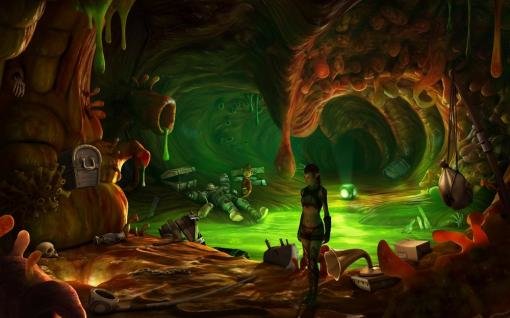
We thought we’d never see an English translation of The Book of Unwritten Tales, but KING Art’s inspired homage to classic fantasy adventures and RPGs finally arrived in 2011, and lived up to every bit of its advanced hype. Its four mismatched characters – elf, gnome, human and critter – embark on an epic journey to save their realm from the clutches of a megalomaniac witch, and en route manage to return adventure gaming to its idealistic, irreverent, inventory-laden, action-packed heyday. Filled with affectionate tributes to pop culture icons like Lord of the Rings, Star Wars, and World of WarCraft, the game also charts its own engaging course in the eternal battle of good versus evil. While it ribs the genre and laughs at itself, it's sharp and serious about its business, treating players to a rare depth and intricacy of gameplay. The numerous quests flow seamlessly and intuitively, and even seemingly offhand comments neatly tie up sub-plots hours later.
The action is set in an exquisitely detailed, multi-dimensional world enlivened by outstanding animation, a nostalgia-inducing background score, and exemplary voice acting. The diverse, memorable supporting cast holds its own against the charismatic leads and adds considerable emotional depth to the story. Its deceptively sophisticated script is at once straightforward and wickedly clever: dialogues are crisp and witty, exposition is kept to an essential minimum, and no time is ever wasted in getting to the point. Though the unlikely swashbucklers have a grand, all-encompassing mission, the game focuses on tracing their tiny, wobbly steps as they visit places they've never heard of and collaborate with people they don't like, eventually discovering strengths of character they never imagined they had. In doing so, The Book of Unwritten Tales reveals a great heart of its own, which will most likely melt that of any adventure gamer who plays it.
You might also like: Ceville, Torin’s Passage, Rent a Hero
#63 – Black Dahlia
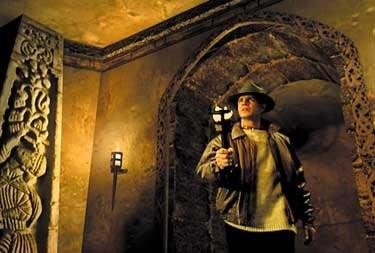
The real-life 1946 murder of Elizabeth Short, dubbed “Black Dahlia” for her dyed hair and all-black wardrobe, is an unsolved mystery ripe for a fictional solution. The equally unresolved Cleveland Torso Murders, a series of 12 dismemberments in the 1930s, has similar possibilities. In Black Dahlia, Take 2 took these two genuine cases and built an intriguing narrative around them that goes well beyond the basic details of the cases themselves. The tale of rookie COI (later to become the CIA) agent Jim Pearson’s investigations merge FMV and computer-generated backgrounds seamlessly, and the look of the game catches the period setting perfectly. In an especially welcome feature, Jim also takes notes of important information, saving players from having to do it themselves.
But what really makes this 1998 adventure a classic for the hardcore adventurer is its significant challenge. This is a game that rarely yields to trial-and-error solutions, and actually has Jim mock using that approach when it is possible. Instead, a keen mind is needed to make any sort of progress through its numerous puzzles, especially in the latter parts of the game where the difficulty becomes even more brutal. This can lead to frustration, but it also means that reaching the solution yourself becomes immensely satisfying. While hard, the game doesn’t resort to illogical leaps, though it is not above laying deadly traps for those who don’t think things through properly. This may not make it one for the casual adventurer’s collection, but in a genre that prides itself on requiring brainpower, this is definitely the thinking player’s must-have.
You might also like: Ripper, The X-Files
#62 – Obsidian

On the surface, Obsidian may resemble Myst for its first-person, puzzle-centric gameplay. But players entering this wildly imaginative 1997 adventure had best leave all such expectations at the door. As the game itself warns, “your rules do not apply”, and any preconceptions are quickly turned upside down – literally. Biochemical engineer Lilah Kerlin and her husband Max Powers invent a new satellite designed to clean the atmosphere with nanobots, but as happens all too often with advanced technology, the satellite evolves into a sentient being whose nanobots create a giant black crystalline object that sucks the scientists into a bizarre world inspired by their own nightmares. Populated by mechanical vidbots with televised faces, there are several realms to explore in sequence, each with its own unique setting and theme, most notably the memorable Escher-like bureaucratic hell that extends from floor to walls to ceiling.
Obsidian is also filled with puzzles – lots and lots of puzzles, many of them quite difficult. This seems fitting from a developer named Rocket Science Games, whose boast of 60 hours of gameplay may be an exaggeration, but probably isn’t far off. The puzzles are always creative and never unfair, but they do require diligence and careful observation to succeed. Equally challenging (if not more so) are the handful of minigames that require a fair amount of hand-eye coordination, including a randomized one right near the end, but any who persevere will be amply rewarded with a final choice leading to two different outcomes. No matter which you choose, you’ll feel both exhilarated and exhausted by the memorable journey to arrive at that point. And you won’t regret a minute of it. Despite its serious premise, it’s got a touch of subtle humour throughout, and it’s all so deliciously surreal that you’ll never forget the experience. If Terry Gilliam ever made an adventure game, this would be it, though only if he’s a big fan of puzzles.
You might also like: Morpheus, Lighthouse: The Dark Being
#61 – Loom

If you didn’t know who made it, you’d never guess that Lucasfilm Games was behind the unique Loom in 1990. Developed by Brian Moriarty of Infocom fame, this unusual fairy tale tells the story of Bobbin Threadbare, a hooded member of a guild whose members control the mysterious powers of music weaving. Bobbin is different from the other members of his guild, however, and his story begins as an outsider, forced to secretly learn a few a basic spell chords through the use of a distaff, a magical rod that reads the sounds of different objects in the physical world. With the right combination of sounds, a Weaver is able to produce spells so powerful that they can alter the fabric of the universe. In a shocking turn of events on Bobbin’s seventeenth birthday, the entire guild is cursed, starting Bobbin on an unforgettable journey that will lead him on a collision course with Chaos itself.
Loom originally appeared across several platforms, including the PC, Amiga, Atari St, TurboGrafx-16 and FM Towns. For its time it offered some incredibly polished pixel art visuals. But what makes the game so endearing is the quality of its story and detailed background; the original release even included an audio tape that recounted the rich backstory. The most memorable feature, of course, is its unique control method, which relies on learning new spells and playing their notes on the distaff to trigger different in-game reactions. With no inventory to collect, playing your staff and a single interaction button are the only controls available to the player. Despite its ease and short game length, this boldly creative approach is fondly remembered to this day, and with its haunting coming-of-age story capped off by a bittersweet ending, Loom is as much a work of art as a traditional adventure game, yet fully enjoyable as both.
You might also like: Lure of the Temptress
Next up: #60-56...
#60 – Another Code (aka Trace Memory)
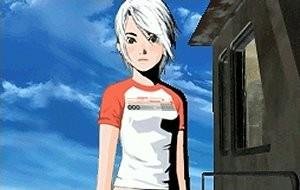
Another Code was the first game to illustrate the potential of the Nintendo DS as a pre-eminent adventure platform, and remains one of the best to this day. This 2005 release by Cing stands out as a true gem not only for its gentle, melancholy story and characters, but also for the ingenious ways the developer utilized the handheld device's hardware. Fourteen-year old Ashley begins the game believing her parents died when she was a young child, but a mysterious letter turns her world upside down when it reveals that her father is still alive on the remote, ominously-named Blood Edward Island. Upon arriving at the island herself, Ashley ventures out on her own to find him. Soon she runs into the ghost of a boy named D, who seems just as lost as she. Together this unlikely pair explores the island and the massive Edward Mansion to discover the fate of Ashley's family and learn more about D's history.
Throughout the game, Ashley uses a DS-analogue device called a DTS to interact with the world. By exploring every object, players can unlock not only Ashley's story but D's as well. Another Code (known as Trace Memory in North America) makes use of every mechanic and feature the DS has to offer, from a variety of touch screen-based interactions to blowing on the microphone to simulate a strong breath to closing the DS lid to trigger the handheld's sleep mode in order to advance. The game’s Japanese developer would go on to create many more innovative adventure games for the system, but Another Code was the first hint of the greatness not only for them but their chosen platform as well.
You might also like: Another Code: R – A Journey Into Lost Memories, Alpha Polaris
#59 – Myst III: Exile

Any fears that the acclaimed Myst franchise would suffer in the move from Cyan Worlds to Presto Studios quickly proved unfounded when Exile was released in 2001. Taking place ten years after the events of Riven, the third installment sees the unnamed, unseen stranger arrive at Atrus's house to see a new Age he has created. However, a mysterious antagonist steals the book, seeking revenge on Atrus for crimes that his sons committed. To track down the perpetrator and recover the book, there are three new Ages to explore. Each world offers its own unique flavour, including the industrial-tinged Voltanic island, the Asian theme park-inspired world of Amateria (with its own rideable roller coaster!), and the lush garden world of Edanna. The locations are wonderfully diverse and beautifully rendered, and for the first time in the series you could sweep the camera completely around you for a full panoramic view.
Returning to the self-contained challenges of the original Myst, each Age has its own assortment of puzzle challenges. As usual, many of them are somewhat mechanical in nature, but while not always easy by any means, they are certainly easier than the puzzles in the first two games. To some this marked a regrettable simplification of the series, while to others it represented a more inviting, accessible experience while still delivering a solid challenge and remaining true to the spirit of its predecessors. Brad Dourif’s (One Flew Over the Cuckoo’s Nest) over-the-top live-action portrayal of the villainous Saavedro also met with mixed reactions, but there’s no denying he threw himself into the role with gusto. In the end, Exile didn’t quite measure up to the quality of its forebears, but it was a worthy sequel in the venerable franchise that still holds up well today.
You might also like: Schizm series, RHEM series
#58 – Star Trek: Judgment Rites
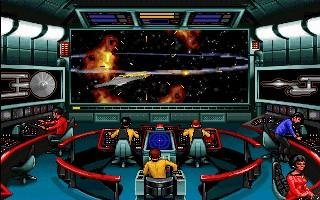
Not only do you not have to be a Trekkie (or “Trekker” in the more acceptable parlance) to enjoy Star Trek: Judgment Rites, but this 1998 sci-fi classic may just make you one all on its own. Although 25th Anniversary was an admirable attempt to adapt the Enterprise, the Federation, and Klingons to the genre, Judgment Rites is a nearly perfect marriage of adventure convention and all the lore and excitement of the Star Trek universe. It features all the original cast members as voice actors; in fact, it would be the last time that DeForest Kelley ever performed as Dr. McCoy in a released product. Interplay was not an adventure genre heavyweight, but they adapted the Sierra-style interface well for their purposes and spared no expense in creating an excellent inter-galactic adventure.
The story of Judgment Rites is a memorable one, with eight individual scenarios that end up tying together in the philosophical tests of an incredibly memorable final chapter. The storylines include such elements as time travel, a kidnapping of a major crew member, and a return of the character Trelane from an Original Series television episode. It is incredible fan service for existing Star Trek fans, but even for the non-fans it is an exceptional science fiction adventure game that is incredibly well written and acted, feeling big-budget and important in every way. The devastating cancellation of The Secret of Vulcan Fury the following year assured its place as the last, but greatest, Original Series Star Trek adventure game.
You might also like: Star Trek: 25th Anniversary
#57 – Indigo Prophecy (aka Fahrenheit)
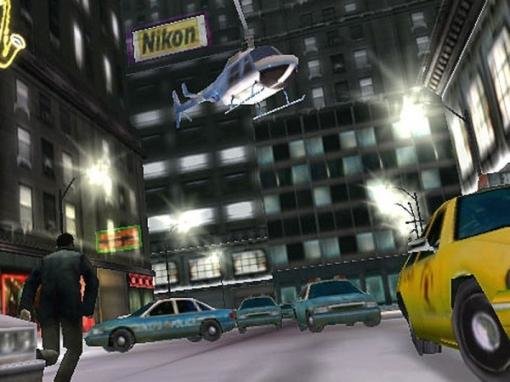
In 2005, Quantic Dream wowed us with the promise of Indigo Prophecy, a dramatic game with a vastly elastic storyline that would change with almost any decision the player made. While the finished product didn’t quite live up to the hype, it is nonetheless a fascinating game that explores a ritualistic murder from the opposing perspectives of the bewildered killer and the cops on his tail. Its gameplay is immersive, its art direction stylish and cinematic, and its storyline engrossing (for the first two-thirds, anyway). Long before the Wii, Xbox Kinect, and PlayStation Move, Indigo Prophecy’s tactile controls – requiring moving the mouse or gamepad analog stick in a pattern that mimics your character’s on-screen action – were one-of-a-kind. Animations and facial expressions are fluid and believable, thanks to extensive use of motion capture. And though the story is sometimes larger than life, it also touches on characters’ personal and even intimate moments, giving us an unparalleled connection to the people we’re controlling.
Set in an atmospheric New York City that’s blanketed in snow and peppered with cinematic camera angles and cuts, Indigo Prophecy (known as Fahrenheit in Europe) was the first game since the FMV era that felt like playing a movie. Its ubiquitous Simon-style Quick Time Events and nonsensical conclusion often draw criticism, but the story-focused gameplay, characters, and initial plot are so well developed and implemented that the game remains an impressive accomplishment. The story may be way more linear than it originally seemed, but tucked within this linearity are a wealth of small actions that players can experiment with to slightly change a scene. At a time when adventures were fighting for mainstream legitimacy, Indigo Prophecy proved that story-driven games can be just as compelling as action blockbusters and feel right at home on consoles as well as PC. It might be a bit too soon to truly understand its impact on the genre, but if the subsequent success of other high-profile games is any indication, the benefit is one we’ll be enjoying for years to come.
You might also like: Red Johnson’s Chronicles, Jurassic Park: The Game
#56 – In Memoriam (aka MISSING: Since January)

French developer Lexis Numérique has been around since the late ‘90s, crafting dozens of licensed titles and children's games. In the English-speaking world, however, they're mostly recognized for creating experimental, high-concept adventure games. Their 2003 release In Memoriam (or MISSING: Since January in North America) isn't just a zany experiment, however – it's a dense, satisfying, well constructed adventure unlike any other. Borrowing ideas from alternate reality games, In Memoriam blends fact and fiction as the player does real internet research while solving a series of riddles and arcade-like minigames to save a journalist and his companion from a deranged killer known as The Phoenix.
The game itself is presented as a CD ROM sent out by the killer, daring you to outsmart him. As the mystery unfolds it directs you to a series of dedicated websites hidden online, which begin to unweave a historical conspiracy that suggests The Phoenix might not be quite as crazy as he seems. The story is pretty stock stuff, and will be instantly familiar to anyone brought up on a diet of Broken Sword or Gabriel Knight. But the attention to detail, the careful verisimilitude and some convincing live-action handicam clips recorded by the victims help make the secret world of In Memoriam a believable and engrossing place. The riddles and minigames are challenging and inventive, and the desperate attempt to free the captives gives even the more abstract puzzling tangible meaning. The game may be an acquired taste, but it remains one of the genre’s first (if not only) forays into the emerging ARG format, and one that may never be bettered.
You might also like: EVIDENCE: The Last Ritual, The Experiment (aka Experience112)
Next up: #55-51...
#55 – Syberia II
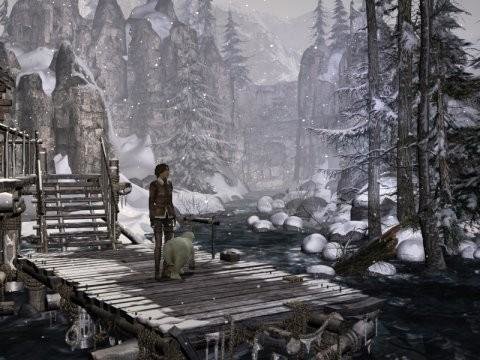
The direct sequel to Microïds’ acclaimed 2002 title, Syberia II came out two years after the original to continue Kate Walker's journey through the frozen Russian wilderness to discover once and for all if mammoths still exist. Now travelling alongside an eccentric aged inventor and the automaton Oscar (plus an adorably furry youki), Kate’s ongoing adventure is a direct extension of the first story, creating a seamless artistic connection between the two. Beautifully serene, hand-painted worlds remain at the forefront of the experience, paired with top-notch writing and sound to create a memorable melancholy atmosphere that few games can rival. Where the game does change things up is by taking a jumping off the wind-up train tracks for treks through the tundra, a run-in with a friendly pilot, a harrowing encounter with a bear, and crossing paths with a couple ivory poachers intent on finding Syberia and its mammoths for themselves. Time is of the essence as well, as her sickly companion may miss out on his only goal in life if Kate cannot find a way to heal him and deliver him safely to the land of his dreams.
The more adventurous storyline is matched by an increased emphasis on puzzle variety and challenge, making Syberia II a more substantial gameplay experience. This new focus does come at the expense of some character development, though having made her life-altering decision the first time around, Kate’s singleminded purpose is understandable. While its predecessor was sometimes criticized for its cliffhanger ending, Syberia II's final sequence is a moving finale, and there are several powerful emotional moments along the way, including a heart-rending sacrifice made by one character in particular. Together with its predecessor, Syberia II is half of a defining work by a true adventure game visionary. Sure, there may still be lots of scenery with little interaction, but the two parts form a classic unlike any other, and the final moments are a worthy reward for seeing the journey through to the end.
You might also like: Paradise, Sinking Island, A New Beginning
#54 – Samorost 2

The celebration of “Samorost Day” has been a running gag around Adventure Gamers for years, but not without cause. The original browser-based Samorost by indie Czech studio Amanita Design took the site by storm in 2004, and its successor upped the ante in every conceivable way. Yet on the surface, it would seem the sequel has no business being so good. It’s very short and has no story to speak of, as a little gnome attempts to retrieve his stolen dog from spacefaring aliens, then find his way home again from an unfamiliar planet. There is no dialogue or inventory, or even much exploration, as you’re usually confined to just a single screen at a time. So why the heck is Samorost 2 so great? Simple: its stunning artwork, enchanting levels with charm oozing out of every pore, and inventive puzzles that use the streamlined Flash interface to wonderful effect. Oh, and did we mention half of it was free?
Like its predecessor, Samorost 2 presents a fabulous game world made up of photorealistic nature images blended with hand-drawn animations. As you journey through forests, sewers, underground networks, and alien homes, you’re traversing utterly foreign lands that still manage to feel strangely familiar, as if you’re a tiny character in the wilds of Earth, now surreal and imposing in their grandeur. The background music only heightens this bizarre atmosphere with its orchestral, occasionally jazzy score. Most puzzles ultimately amount to simply clicking the right sequence of hotpots in order, but their brilliant integration makes them feel like organic environmental obstacles to overcome, whether it’s distracting a snail from fixing its shell so you can borrow its hammer or waking up a snoozing robot. You’re alone on an alien world, with no idea what anything does. What would YOU do? Experiment! As a shareware offering, some may have balked at paying for only half of a two-hour game, but others were more than happy to double the time spent in this creative, wonderful world, counting the cost as an investment in Amanita to see what they could do with a full-fledged adventure…
You might also like: Samorost, Axel & Pixel, Alchemia
#53 – Return to Mysterious Island

Usually you can separate adventures into two camps: solitary first-person adventures with obtuse logic puzzles, and third-person adventures with a heavy emphasis on inventory puzzles. Kheops Studio’s Return to Mysterious Island pitched those distinctions out the window in 2004, with delightfully surprising results. After a shipwreck, a young woman named Mina washes up on a deserted island, where she needs to survive on whatever the island offers her before she can even begin thinking about finding a way off. While thoroughly exploring to find crucial items, you will traverse beautifully rendered coastal shorelines, tropical jungles and underground caves. You’ll also discover this island is the one Captain Nemo's submarine “The Nautilus” was stranded on ages ago. Remnants of the surviving crew’s habitation are everywhere, including equipment and notes on how to use them.
So far, so very standard first-person. Where Return to Mysterious Island really veers off the beaten path is in its brilliant inventory use. Collectable items abound, most of them needing to be combined or disassembled to create complex new objects, often with multiple solutions leading to the same goal. While most games treat combinations as simple “Use X on Y” exercises, here each construction is an actual recipe. Connect two compatible items and a formula appears telling you how many items are needed to succeed, without actually telling you exactly what those items are. It’s an inventory puzzler’s dream, and great fun to tinker with dozens of ingredients until you get it right. You’re not entirely alone, either, as you’ll nurse a cute little monkey back to health, who then pitches in as a functional inventory item himself. The endgame includes a deluge of logic puzzles and complex riddles for a little variety, but the true joy of the game is its unbridled MacGyverism, with a welcome sense of sense of realism, immediacy and tangible consequence that most adventures lack.
You might also like: Return to Mysterious Island 2, VOYAGE (aka Journey to the Center of the Moon)
#52 – Dreamfall: The Longest Journey
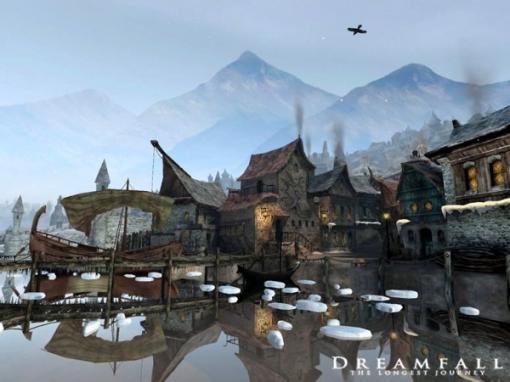
It took seven years, but fans of Funcom's The Longest Journey saw their dreams of a sequel realized in Dreamfall: The Longest Journey. Yet it is a much different game than its classic predecessor, in every conceivable way. April Ryan, the intrepid ingénue from the first game, is battle-scarred and world-weary, and this time around she’s joined by the mysterious assassin Kian and the rudderless but loyal Zoë Castillo. All three are playable characters, and as you follow the metaphysical and literal journeys of each, you begin to unearth the secret world that connect dreams to reality. Ragnar Tørnquist once again proves himself a master storyteller with enough imagination to fill two worlds: the futuristic Stark and the fantastic Arcadia. As you shuttle between the two, you begin to catch glimpses of how these worlds are tied together even as you occasionally stumble upon a vague in-between realm that may hold the answers to the strange forces that threaten to unravel both worlds.
Complementing the fabulous voice acting and immersive sound work, the game’s move to a full 3D environment gives the complex story room to breathe. The world you explore is gorgeously cinematic and totally immersive, at least once you get used to the keyboard and mouse (or gamepad) to move and control camera angles. Adventure gamers may hesitate over a game that includes brief fighting and stealth sequences (none requiring fast reflexes, and many of them avoidable to begin with). However, these elements are brief and help bring tension and a sense of urgency to a story that still includes its fair share of inventory puzzles and long dialogues with a variety of characters like Wonkers the Watilla, a robotic toy gorilla that has been with Zoë since she was a child. Don’t let the less traditional adventure elements scare you away; with its complex tale of three characters struggling to find balance between loyalty and love, between honor and morality, Dreamfall achieves just the right balance between wonderful storytelling and immersive gameplay.
You might also like: 80 Days
#51 – Zork Nemesis
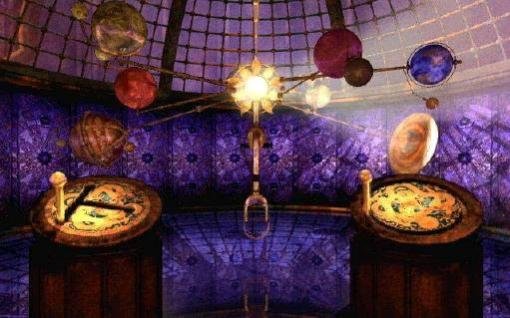
If this game were simply called Nemesis, it would be widely acclaimed as one of the best puzzle-adventures ever made. It still is, of course (as evidenced by its presence here), but there are some who just can’t reconcile its dark, at times disturbing atmosphere with the wacky world of Zork. And indeed, beyond a few subtle references, Activision’s 1996 game has nothing in common with its predecessors, making it more a spin-off adventure than genuine sequel. Taken purely on its own terms, however, it’s an excellent example of what can be done by pushing the solitary, puzzle-centric Myst formula in new and interesting ways. The Great Underground Empire’s four top alchemists have all disappeared in the Forbidden Lands, and it’s your job to seek them out. Unfortunately, you soon discover that they’re dead, or at least trapped in a sort of undead captivity by an evil entity called the Nemesis. Guided by their spirits, now only you can complete their work by retrieving the items needed to resurrect them, though the more you follow in their footsteps, the more you come to question their motives as well.
Your travels take you through four distinct realms representing the natural elements, including such locations as an asylum, castle, monastery, and a musical conservatory. These aren’t whimsical fantasy settings, however. Evidence of torture and cruelty is everywhere, and you’ll be required to behead a corpse with a guillotine yourself. (But hey, is that worse than being eaten by a Grue?) All this is observed using the game’s proprietary Z-Vision Surround engine, which in its day helped pioneer the now-common 360-degree, node-based camera panning, with over an hour of full-motion video sprinkled in between. A haunting musical score rounds out the ominous mood and provides the backdrop for the many challenging puzzles that await. Some of the game’s 65 challenges are quite difficult, making for a lengthy, substantial adventure before reaching the stunning conclusion, by which point you’ll be questioning everything you thought you knew. It may not be very Zorkian, but when games are this good, does it really matter what they’re called?
You might also like: 9: The Last Resort, Dracula 3: The Path of the Dragon
Next up: #50-46...
#50 – Infocom text adventures

Okay, so we cheated. But really, how can we not? The wealth of text adventures in the genre’s early days could fill up a best-of list all on their own, many of them supplied by Infocom. The company who helped catapult the genre (and computer games in general) to the forefront with the original Zork went on to produce a prolific lineup of successful adventures for the better part of a decade. Founded in 1979 by several MIT staffers, Infocom was the name in interactive fiction until it was bought out by Activision in 1986 (though new games continued to appear under the Infocom label for some time after that). Infocom text adventures eschewed the rudimentary graphics emerging at the time to create rich virtual worlds filled in as much by the player’s imagination as the extensive descriptions offered on-screen. The text parser, while certainly limited in scope, nevertheless offered an unparalleled level of immersion in directing your own adventure. Such freedom to experiment has since been sacrificed in the name of point-and-click accessibility – a loss that many lament to this day.
But who can pick just one? Written by co-founders Dave Lebling and Marc Blank, plus other noted “Implementors” like Steve Meretzky, Brian Moriarty, and Bob Bates, the choice of favourite Infocom games ultimately came down to preferred genres. Fantasy lovers were rewarded with the Zork and Enchanter series; sci-fi fans were treated to classics like Planetfall, A Mind Forever Voyaging, and The Hitchhiker’s Guide to the Galaxy. Not your cup of tea? There were mysteries like Suspect, The Witness, and Sherlock: The Riddle of the Crown Jewels; and comedies such as Leather Goddesses of Phobos, Bureaucracy, and Hollywood Hijinx. Many still think that The Lurking Horror is the most terrifying adventure to date. The list goes on. Often sold in bookstores, the games even included notable “feelies” to serve as copy protection, though most were treasured as bonus extras in their own right. It was a different era then, and a magical time to live through for those who were a part of it. The text adventure lives on today in a thriving Interactive Fiction community, but the adventure genre itself owes much to the undisputed early brilliance of Infocom.
You might also like: Magnetic Scrolls and Scott Adams adventures, 1893: A World’s Fair Mystery, Photopia
#49 – Sam & Max: Season Two (aka Sam & Max Beyond Time and Space)

It may seem unusual to treat five separate releases as one entry, but the five installments of Sam & Max: Season Two combine to form an exceptional work when taken as a whole. Unlike the first season of Telltale’s episodic revival of everyone’s favorite canine shamus and hyperkinetic rabbity thing, where the episodes were knitted together only by a thin thread, there was a real connected story the second time around – an absurdly bizarre and unspeakably insane one, of course, which begins with gunfire and demonic possession as a backdrop for the Christmas holiday, continues through trips to Easter Island, the undead city of Stuttgart and its vampire raves, takes a diabolically hilarious time travel sojourn, and ultimately winds up with an infiltration of the nefarious corporation known only as Hell, LLC. And yet none of that description even hints at the hilarity of the brilliant writing and puzzle design on display.
Throughout the season (which came to be known as Sam & Max Beyond Time and Space in console ports), the humour is top-notch absurdism, with perfect references to past events in the series and nearly ideal use of supporting characters to maximum comedic effect. Telltale wisely extricated themselves from the need to make each episode standalone, as they did in Season One, and instead went all-in for the cliffhanger approach. At the time we described the series as “completely, certifiably nutso” and therein was the incredible magic and charm of the experience, the full realization of what Steve Purcell’s beloved characters were meant to be. Thanks to those infamous “marketplace realties”, a Freelance Police sequel once seemed never meant to be, but in Telltale’s hands, Season Two became a modern classic exploding with the ambition and lunacy of the best Golden Age comedy adventures.
You might also like: Sam & Max: Season One and Sam & Max: The Devil’s Playhouse
#48 – Space Quest IV: Roger Wilco and the Time Rippers
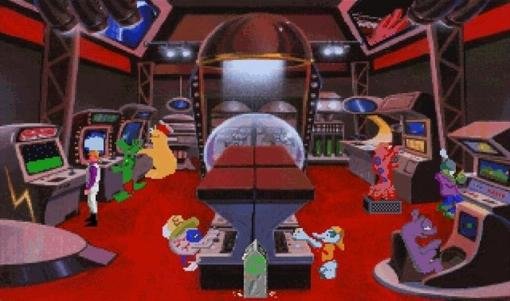
Any of Sierra’s Space Quest games could rightfully stake a claim as the series’ best, but there are mainly two words for why Space Quest IV: Roger Wilco and the Time Rippers gets the nod. No, not “Scott Murphy” or “Mark Crowe”, though the self-proclaimed Two Guys from Andromeda penned consistently hilarious scripts. Rather, it’s “Gary Owens”, the Laugh-In announcer who was nabbed to voice the narrator in the 1992 CD-ROM release a year after the original floppy disk version. Owens delivered a masterfully sarcastic, over-the-top performance that raised an already funny franchise to otherworldly heights. He even made dying hilarious, which is a good thing, as you’re likely to do so many, many times. Those aren’t the only laughs, of course. Though there are more pop-culture references and less sci-fi parody here than in other games, the superfluous “Taste” and “Smell” interactive options offer plenty of amusing responses as well.
The time-travel plot is a predictably zany hodgepodge of events, as Roger unwittingly (does he know any other way?) finds himself transported back and forth through time, from his original adventure in Space Quest I to a fictional future sequel in Space Quest XII. The game itself was entirely modern for its day, however. This was the first game in the series to move from text parsers and EGA graphics to the brave new world of point-and-click, VGA graphics, and the upgrade was significant. And when the CD “talkie” version was introduced, it came at a time when few other games were yet making use of the new medium, making this game one of the more progressive adventures of its era. Yes, there are dead ends and the puzzles can be unintuitive, but as the funniest game in one of the most storied adventure series ever, it’s Space Quest IV that stands above the rest.
You might also like: Space Quest series
#47 – Professor Layton and the Curious Village
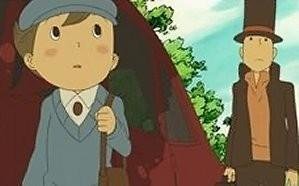
Level-5’s Professor Layton and the Curious Village is a game full of puzzles – lots and lots of logic puzzles. Sound boring? It’s not! Already popular in Japan but virtually unknown around the world before its 2008 release, the game is ideally suited to the portable Nintendo DS and brief rounds of on-the-go gaming. And yet it’s addictively easy to become obsessed with overcoming devious wordplay, deceptive riddles, and puzzles that have you manically (or strategically, if you’re patient enough) sliding pieces around. There are even puzzles that convince you that you’re doing math when you’re really not. The challenges are confounding, surprising, and full of “aha!” moments – the kind that fill you with elation because you were sure you’d never be able to solve that one on your own… though there are always hints if you really can’t.
But this isn’t just a puzzle game by any means. These brainteasers are wrapped in a beautiful, charming, and cozy cartoon-like presentation. Plentiful cinematics fill the tiny DS screen with rich, lively animation and crisp dialogue. And when you’re not knee-deep in a puzzle, the game has you out adventuring with top-hatted English gentleman Professor Layton and his plucky sidekick Luke as they attempt to locate a secret artifact. All around them are quirky, eccentric townsfolk to chat with, and a myriad of collectibles and minigames to discover. Other Layton games have continued to carry the torch, but Curious Village was the first to capture our hearts and strain our brains. Who knew a collection of a hundred-odd puzzles could make for such a wonderful, cohesive adventure?
You might also like: Professor Layton series, Puzzle Agent series, Safecracker series
#46 – The Journeyman Project 3: Legacy of Time
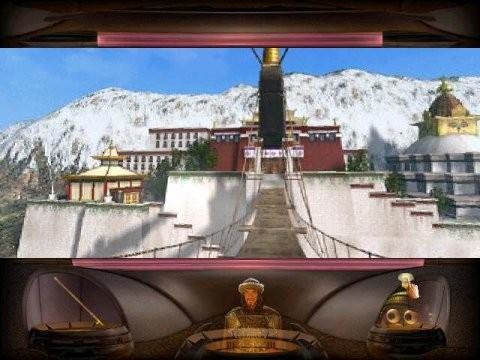
Sequels can all too often be lacklustre retreads of their predecessors, but such was not the case with Presto Studio’s Legacy of Time in 1998. The final installment of The Journeyman Project took new paths to form a memorable conclusion to the trilogy, while still being mindful of its roots. With Earth under pressure to dismantle its time travel technology, the agency tasked with protecting time is unprepared when a massive disturbance hits, so returning hero Gage Blackwood is sent back in a prototype suit to investigate. There he meets old foes and friends (including fan favourite, Arthur the A.I.), and thwarts a conspiracy that could destroy the world. The story rounds off the overall arc skillfully, providing better insight into the motivations of the villains and showing things weren’t quite as black and white as we thought, which makes for a particularly satisfying conclusion.
The lush historical scenes, from warm Mediterranean waters to the snowy Himalayas, get a much bigger share of the screen this time, a deserving increase given the loving detail lavished on them. They also smoothly incorporate FMV characters into their computer-generated backgrounds. The controls have also been streamlined, making for a much smoother interface than before. For the first time in the series, you even get to interact with people in the past. Through the chameleon ability of the prototype suit, you can copy the appearance of natives, allowing you to subsequently wander around and chat with others undetected. The different reactions you get based on who you are impersonating keep things interesting, and are also integral to the puzzles. With Arthur as witty and informative a companion as in the previous installment, the sum total is a triumphant sequel that offers an enduring legacy of entertainment.
You might also like: Atlantis series, AGON series
Next up: #45-41...
#45 – The Curse of Monkey Island
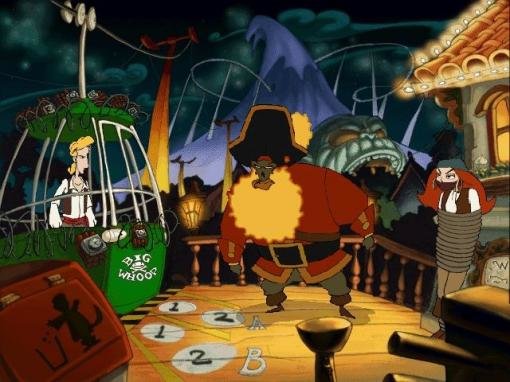
Series creator Ron Gilbert may have parted ways with LucasArts, but that didn’t stop the company from continuing the Monkey Island franchise, and in 1997 The Curse of Monkey Island marked a welcome return to the wacky world of Guybrush Threepwood. Helmed by the team that brought us Full Throttle, the third game changed the look, sound, and feel of the series considerably, but kept the familiar humour that we’d all come to love. The stunning graphical overhaul was evident from the get-go. Gone was the darker, more realistic pixel art look of LeChuck’s Revenge and in its place was a more vibrant, hand-painted cartoon style that still looks great today. It also managed to build successfully on the established brand, introducing excellent new additions like Murray the talking skull and some exotic new locations.
The most important addition to the series, however, was the inclusion of voiced characters for the first time: Guybrush, Elaine, and LeChuck were now brought fully to life by the likes of Dominic Armato, Alexandra Boyd and Earl Boen. Suddenly there was new depth to characters we already felt comfortable with and all proved immensely popular, the actors continuing in their roles even to this day. The game was not immune to criticism, mainly focused on its short length and abrupt ending, and it never quite achieved the heights of its predecessors, especially by those who questioned its place in Monkey Island canon. Still, it’s undoubtedly an excellent continuation of the series and a fantastic adventure game in its own right.
You might also like: Ghost Pirates of Vooju Island, A Vampyre Story, So Blonde
#44 – Simon the Sorcerer
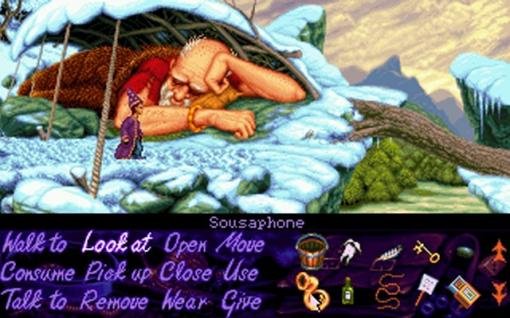
Simon the Sorcerer is a very British game. It takes a certain sense of humour to truly enjoy everything it has to offer, but for those who share it (and there are many), this is a wonderful game. Released in 1993, Simon was AdventureSoft’s breakaway property after a string of minor successes. A full-blown parody of fairy tales and fantasy tropes with a particularly dry sense of humour, a Disney classic this is not. From the pig-faced Rapunzel to the drunken dwarfs, few beloved children’s characters survive unscathed. Simon himself is an obnoxious youth with few redeeming features, and the supporting characters are equally repellent. All the elements are wrong, and yet the finished result is not only charming, it is extremely fun to play.
The young apprentice’s first journey into the vast and vibrant magical realm made use of revolutionary technology at the time, sporting some beautiful living backdrops that kept the forest perpetually alive. The soundtrack was similarly lauded for its accomplishments, offering tunes you could easily identify even now if heard out of context. The script is chock-full of fantastic put downs and witty one-liners brilliantly voiced by Chris Barrie from Red Dwarf, and although Simon is thoroughly vile to everyone he meets, you can’t help but love the guy. The save-the-world-from-evil-sorcerer story is thin, and the puzzles are often odd inventory combinations that make little sense, but Simon’s first adventure qualifies as a bona fide classic that went on to spawn four different sequels and a couple of spin-off games. Not bad for that other British teen wizard.
You might also like: Simon the Sorcerer series (yes, even 3D)
#43 – John Saul's Blackstone Chronicles
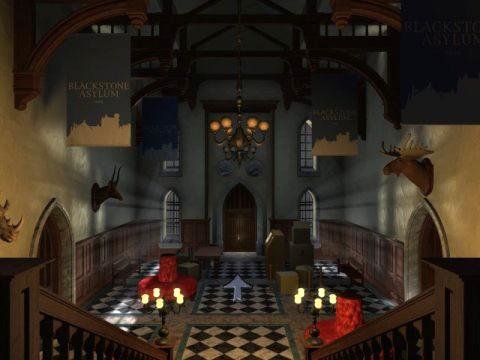
Another underrated (though not by us) adventure from Legend Entertainment is John Saul’s Blackstone Chronicles, a chilling 1998 adventure that takes place entirely in a former insane asylum. Picking up several years after the serialized stories of John Saul left off, the asylum is now a Museum of Psychiatric History that Oliver Metcalf must explore in search of his son, who’s been kidnapped by his own father, the last superintendent before the asylum closed down. The problem is, his father is dead, and he isn’t the only ghost lurking within these walls. Accurately billed as an “adventure in terror”, it’s not because the game uses cheap scare tactics and gory images. There is no observable violence, bloodshed, or gore. The horror in Blackstone Chronicles is purely psychological – only ever implied, and 100% human. It's subtle, clever, and insidious, and though it's less frightening than it is disturbing, the more you invest yourself in the story, the more alarmed you'll become.
The true heart of the game is delving into the experiences of those who suffered through torturous treatments in the name of mental "health care." Reading about abominable real-world historical treatments is made all the more horrific when you listen to the first-hand accounts of ghostly former patients. If you aren’t touched by the heart-rending fate of the little boy who simply liked playing with dolls, you don’t have a heart. You’ll even get up close and personal with such actual devices as the electroshock chair, a coffin-like heat chamber, and the fever therapy device where patients were cut open and bled. A few timed puzzles only add to the frightening atmosphere, requiring quick thinking rather than reflexes, though that’s hard to do when your pulse is pounding a mile a minute. All the while, Oliver’s father Malcolm provides one of the most impressive acting performances ever – his voice, tone, and delivery all perfectly conveying the arrogant, calculating, emotionally disconnected sociopath he clearly is. Combined, these factors make Blackstone Chronicles an overlooked revelation among adventures, proving once and for all that true horror begins in the mind.
You might also like: Shivers series
#42 – Conquests of the Longbow: The Legend of Robin Hood
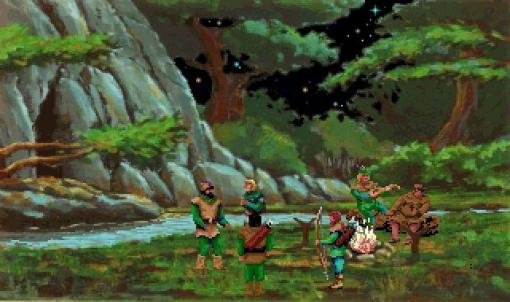
Robin Hood is one of those legendary characters who has made a lasting impression, forever imprinted in our collective imagination. In the second (and sadly final) adventure in the short-lived Conquests series from the pen of Christy Marx, one of Sierra's finest designers (if often forgotten among more recognizable names), Conquests of the Longbow put players directly into Robin's leather boots in 1991 to embark on a classic cloak-and-dagger adventure. It's a powerful tale, backed by copious details about Druidic folklore and English history, in a world populated by iconic characters like Little John and Will Scarlett, the Sheriff of Nottingham and Maid Marian, here in the imaginative role of a Druidic priestess. The gameplay also proved to be incredibly fun, full of innovative puzzles and challenging riddles flawlessly integrated with the storyline.
The real pièce de résistance of The Legend of Robin Hood, however, is the player-guided nature of the gameplay that allows for branching paths and multiple finales. Depending on the choices made and actions taken at pivotal moments, the game plays out a little differently, and there are four possible outcomes that take into consideration how successfully Robin worked against Prince John and his sycophant, the Sheriff, to restore England's rightful ruler to the throne. The lavish graphics and beautiful, fairy tale-like soundtrack significantly add to the mood, creating an exciting adventure that offers just the kind of entertainment one would expect of a Hollywood movie about the Prince of Thieves (and much better than the ones we usually get).
You might also like: Conquests of Camelot: The Search for the Grail
#41 – Ghost Trick: Phantom Detective
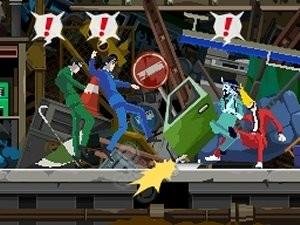
Rather than continuing to milk the safe gameplay formula of the successful Ace Attorney series, in 2011 Capcom’s Shu Takumi created Ghost Trick: Phantom Detective, a non-sequel with an entirely new gameplay mechanic. The result was a unique and satisfying experience that shows the risk taken was a thoroughly worthwhile one. The ghostly Sissel has just one night to solve the mystery of his own death, and interacting with the world comes solely through possessing items and using his supernatural will to operate them. Using these “ghost tricks”, Sissel accomplishes tasks from simply getting around to foiling assassinations and escaping sinking submarines. The variety of tricks available provide diverse and interesting puzzle challenges, further increasing in complexity when a second spirit with different abilities is later added to the mix.
Thankfully, having broken away from the pack with an interesting new gimmick, the designers did not just rest on their laurels. The game also boasts gorgeous anime-style graphics with a wealth of detail packed onto the small Nintendo DS screens. All scenes, from an opulent office to a junkyard set against a cityscape backdrop, are a pleasure to the eye and filled with a variety of interesting and beautifully animated characters. The ghost trick control system is also developed far beyond its basic premise. When encountering a dead body, your spirit self can travel back to four minutes before they died, rewinding time as often as necessary to prevent their sad fates. Topping all this off is a plot that twists and turns, constantly changing the player’s understanding of events. The combined result is a one-of-a-kind game that deserves to be in any adventure gamer’s collection.
You might also like: Ghost in the Sheet, Gast: The Greatest Little Ghost
Next up: #40-36...
#40 – Myst IV: Revelation

The Myst franchise changed hands once again after the release of Exile, as Ubisoft took over the reins for 2004's Myst IV: Revelation. Thankfully, the result was an exceptional game that combined all the elements that made its predecessors so great while adding a few dynamic qualities of its own. Not only does it tell a fantastic story, but in sending players to the worlds where Atrus’s sons are imprisoned (along with two others), the artists created what is arguably the best looking Myst game ever created. The new Ages are incredibly diverse, from the fog-enshrouded tower peaks of the dreary Spire to the prehistory-tinged land of Haven, and each is filled with little animations that bring them to vivid life. To capture it all, Myst IV shipped only on DVD, helping pioneer the shift to a new medium just like the original Myst did more than a decade earlier.
Revelation isn’t all beauty without brains, of course. After the relative ease of Myst III, the puzzles here are extremely complex and challenging, yet always fair and nicely integrated. To help keep track of clues, for the first time in the series a camera was provided to photograph important details for later reference, and a personal journal allowed for in-game note taking. The interface was updated with additional interactivity as well, requiring you to physically pull levers or turn pages in a book. This was mainly a cosmetic addition, but it added to the overall sense of immersion. And by returning the storyline to its original roots, players were once again given a choice between the two brothers, offering another chance to determine their fates once and for all. Though the genre’s heyday was long gone by the time of its release, Myst IV proved that the franchise still had the power to deliver a compelling puzzle-adventure experience that few others have ever surpassed.
You might also like: Aura series, Keepsake
#39 – Last Window: The Secret of Cape West

As the sequel to Hotel Dusk: Room 215, Cing’s Last Window: The Secret of Cape West had its work cut out for it, but it was clearly up to the challenge and then some. In the ongoing story of ex-cop Kyle Hyde, now door-to-door salesman and finder of things that don’t always want to be found, Kyle is without a job and soon to be without a home. But his life takes an even more unexpected turn when he is offered a chance to find out what happened to his father 25 years ago, right there in the same apartment building that’s about to be demolished. Before long, you’ve become fully immersed in yet another gritty interactive story, with its hand-drawn graphics and film noir-like atmosphere that make the game very hard to put down. Not when there’s so much to do, as exploring the Cape West apartment building involves visiting and interrogating fascinating characters and solving well-integrated, multi-solution puzzles, all while discovering plenty of dark secrets along the way.
As with the first game, the Nintendo DS is held sideways like a book while playing, and the shoulder buttons, microphone, and folding platform itself are put to good use in situations where the player’s actions perfectly mimic in-game activity. The game also introduces several new improvements over its predecessor, and even includes a full novelized version of your exploits in detail at the end of each chapter. This is a great refresher if you’ve been away from the game (it’s so long you’ll have to put it down once in a while), though you’ll likely be eager to dive right back into the game, if only to access the impressive jazz soundtrack from the in-game jukebox. You need to love reading to enjoy games like this, but if you do, Last Window is a masterpiece of interactive fiction brilliantly blended with graphic novel sensibilities. It may have been the swan song for its talented Japanese developers, but they certainly went out on a high note.
You might also like: Again
#38 – Full Throttle

The words "effortlessly cool" are not normally attached to point-and-click games, but Full Throttle is precisely that. The epic opening sequence of a lone biker’s inner monologue as he drives along a highway sets a riveting stage for the high-octane adventure to come. Written and designed by Tim Schafer, the 1995 motorcycle-themed release offered lavish graphics, a brilliantly voice-acted cast of characters, and a rockin' soundtrack. If there’s one teensy little flaw, it’s that it’s short – really short. So short you’ll think you’ve done something wrong when the credits roll. It’s perhaps the only real reason (and maybe a few ill-conceived action sequences) it doesn’t occupy a more elevated position on our list. But being left wanting more isn’t just a testament to its abbreviated length, but also the quality of the adventure to that point.
Full Throttle represented a big step forward both graphically and technically for LucasArts in 1995. The soundtrack featured biker band The Gone Jackals, the first time commercial music had been used in one of their games, while the SCUMM engine was overhauled entirely and the superb voice cast sported names like Tress MacNeille (The Simpsons) and Mark Hamill (Star Wars) on the roster. The cast is first-rate, with the late Roy Conrad's grizzled anti-hero Ben providing a completely new take on the point-and-click protagonist; a guy you can never quite understand and would certainly never want to meet in a dark alley. The art direction was unparalleled at the time, and its bleak, dystopian setting was brought vividly to life with some gorgeous backdrops and cutting edge animation thrown in to round it all off. It may have ended too soon, but Full Throttle was one game that fired on all cylinders while it lasted.
You might also like: Hector: Badge of Carnage series
#37 – Stacking

A game where every character is a Russian nesting doll can be easy to dismiss as child’s play, but Double Fine's 2011 downloadable Stacking has a charming appeal as broad as its humour. Set in 1930s America, the game stars Charlie Blackmore, the smallest matryoshka doll in the world whose family has been abducted by a cruel captain of industry and forced to work under horrible conditions to advance the tycoon’s vague-yet-diabolical plot. Overlooked because of his size, Charlie uses his diminutive stature to – in true stacking doll fashion – jump into a series of incrementally larger dolls in order to solve puzzles, free his family, and ultimately stem the tide of greed and corruption that threatens the working class. In another compelling touch, all the action is displayed in a stylish period vision, complete with cinematic silent film dioramas.
What makes jumping into other dolls so much fun isn't just their often funny reactions to the sudden invasion, but the fact that each dolls boasts a special ability. Some, such as headbutting people or performing a pantomime, are simply for colour or to accomplish one of the game's many sub-goals, but many of them, such as attracting the attention of lusty men, are integral to solving puzzles. Deep down, Stacking uses the same tried-and-true “find the key to open the door” gameplay employed by countless other adventures, but here the “key” is another doll or sequence of dolls and the “door” ranges from a staggered piano concert to an absurd dog race, which is what makes the game so engaging and utterly unique. Simple in design, Stacking turns the basic elements of adventure gaming on their ear – not by obfuscating puzzles through layers of absurdity but by iterating on one simple change. This not only makes the game eminently entertaining but elevates it to a high shelf in gaming history.
You might also like: Zack & Wiki: Quest for Barbaros' Treasure
#36 – Sanitarium

Sanitarium may start with a clichéd premise – horrible car accident, man wakes up unable to recall his own identity – but from the moment you discover the protagonist wrapped in heavy bandages in a decrepit mental hospital, every detail becomes suspect as you begin a surreal journey through the patient's psyche to discover the truth about his condition and his past. Throughout the game, the story alternates between the “real world” of the sanitarium and the twisted depths of the protagonist's mind, which manifest as a variety of disparate locales, from a mutant plant-infested farm to an Aztec civilization to a weird alien bug world. Not only does the landscape change, the character does as well in reaction to the “reality” he is currently facing. While you are Max Laughton in the hospital, once you enter his mind's eye, you will transform into characters such as a tribal god, a multi-armed Cyclops, and a little girl. While the transitions may seem nonsensical at first, they all come together in the end, and along the way you experience a truly affecting and horrific story of love and loss.
Initially marred by some technical issues upon its release in 1998, including a game-stopping bug in the second area, Dreamforge’s magnum opus marched on and eventually received critical recognition for the creativity of its settings, the strength of its narrative and the quality of its puzzle design. Like a David Lynch movie, it’s impossible to tell fantasy from reality, though you’ll constantly try to piece together each tantalizingly cryptic piece of the memory puzzle as you encounter them. While not a “horror” game per se, the ever-changing but consistently creepy atmosphere is among the best the genre has had to offer before or since. Along with its rotating world mechanic and switching protagonists, it also has one of the most sincere and genuinely moving moments in gaming history. While the game failed to set the sales charts aflame, Sanitarium has rightly come to be considered a cult classic among adventure gamers, and is a worthy addition both to this list and any gamer's library.
You might also like: Overclocked: A History of Violence, Phantasmagoria: A Puzzle of Flesh
Next up: #35-31...
#35 – The Neverhood
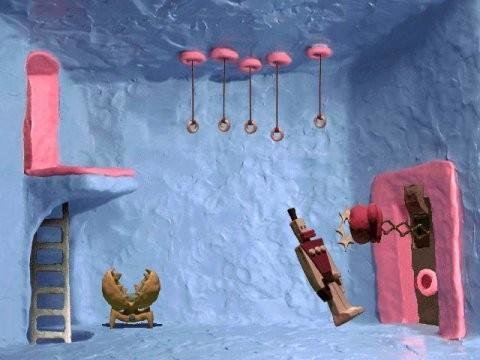
The result of animator Doug TenNapel's imagination, The Neverhood is one seriously bizarre game – which of course we mean in the very best way. With literally tons of clay used in its painstaking hand-crafted construction, the 1996 release featured stop-motion claymation graphics that not only look great a decade later, they will always look great. This game tells the surreal tale of a character named Klaymen on his journey to… well, it's not always clear. Players are thrust into the world with little explanation, which only makes things weirder as you explore this mostly deserted plasticine world. The story eventually coalesces as Klaymen tries to take back the Neverhood from the evil usurper Klogg, all the while picking up scattered video disks that piece together an intriguing origin tale. (And if that isn’t enough background, the phenomenally detailed Hall of Records fills in all the other blanks, and then some.)
There are plenty of puzzles ranging widely in style and difficulty, but this game is fondly remembered more for its absurd style and humour, striking orchestral scores and unique visual aesthetic. Delightfully whimsical animations abound, making great use of the creative freedom such a pliable medium allowed its designers. The game was released at a time when good FMV cinematics were still a breathtaking thing to behold, and while we may be beyond that initial awe, the cutscenes here still hold up to this day, with delightful pacing and gags. To anyone playing the game for the first time: eat the fruit from the tree. Eat a bunch of them. Your inner child will be rewarded handsomely. Even without an actual game to play, exploring The Neverhood would be a dreamlike adventure of memorable sights and sounds, but its many puzzles and wistful creation tale make it all the more outstanding an achievement. Other games have dabbled in claymation, but there’s only one Neverhood.
You might also like: The Dream Machine: Chapters 1 and 2, Wallace & Gromit’s Grand Adventures
#34 – Amnesia: The Dark Descent

With absolutely no exaggeration, we can safely (or not so safely, as the case may be) proclaim Frictional Games' Amnesia: The Dark Descent as one of the greatest – if not the greatest – horror games ever made. This indie adventure may be too consistently intense for some players, but if you enjoy being reduced to a quivering, whimpering nervous wreck, you’ll get your wish here. Without gore or cheap scares, without combat of any kind, Amnesia works on you slowly, building tension with patience and foreboding atmosphere, and then, when you least expect it, throwing you into the maw of danger with no defenses. It may not feature the most devious puzzles, but some brilliant use of physics makes for memorable solutions that feel natural and realistic, and just try completing them while scared out of your wits and on the run.
But no one plays a game like Amnesia to solve puzzles; you play for that nightmare adrenaline rush you get from the greatest horror stories. The tale of an amnesiac protagonist’s struggle to uncover the secrets of the Prussian Castle Brennenburg isn't exactly brilliant of its own accord, but the castle is the setting for some seriously unsettling atmosphere. Distant groans and scratches ratchet the anxiety as shadowy figures flicker past in the dark until you can't take it anymore – and then they keep coming. And when you really, really can't take it anymore, the curtain falls and you're under siege from hideous, unknowable creatures that sap your life force. But careful! Hiding in the darkness may save your hide, but at the cost of your sanity, which will deteriorate until your vision is blurred and your movements impaired. So keep a lantern and a change of pants ready, because Amnesia: The Dark Descent is the scariest adventure game of all time – and it's coming for you.
You might also like: Azrael’s Tear
#33 – L.A. Noire
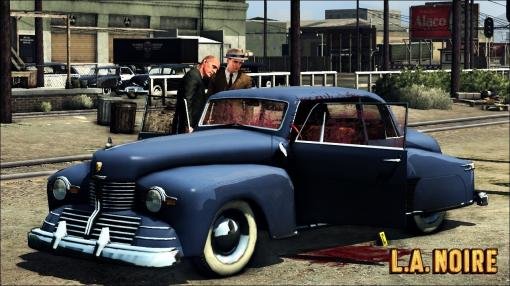
It wasn't a surprise to anyone when Rockstar announced that its 2011 project was heading to 1940s Los Angeles, the home of classic hard-boiled noir films and novels. But it was a surprise to hear that the game would minimize much of the running, gunning, and mischief of Grand Theft Auto and instead focus on exploration, clue-gathering, interrogation, and puzzle-solving. Why... it almost sounded like – could it be? An adventure game? Yes, it turned out that L.A. Noire became one of the most expansive, immersive, and enjoyable adventure games ever made. What begins as a series of unconnected cases turns into a brooding and complex tale of corruption, deception, and temptation that takes some rather unexpected turns. There are still some gunfights and car chases along the way, but many are optional and take a distant back seat to the gritty investigative gameplay.
The game stars Aaron Stanton (Mad Men) as war-hero turned LAPD gumshoe Cole Phelps, along with a host of wonderful character actors who bring a depth to their roles not usually seen in gaming. The gameplay transitions smoothly from driving around a massive, historically accurate recreation of ‘40s L.A. to intricate exploration of crime scenes to intense shootouts and even more intense interrogation. The interrogations are the definite highlight, featuring Rockstar's revolutionary facial capture technology. What other game forces you to scan characters' expressions for facial tics and other tells that signal lies? Even more impressive, the game managed to forge its own identity while still touching on all of the themes and motifs you'd expect from a detective mystery of that era. Bringing together the best of Grand Theft Auto, interactive movies, old-school adventure games, and film noir, L.A. Noire is an amazing achievement that rightfully takes its place among the best adventure games ever made.
You might also like: Law & Order series, Noir: A Shadowy Thriller
#32 – Gabriel Knight: Blood of the Sacred, Blood of the Damned
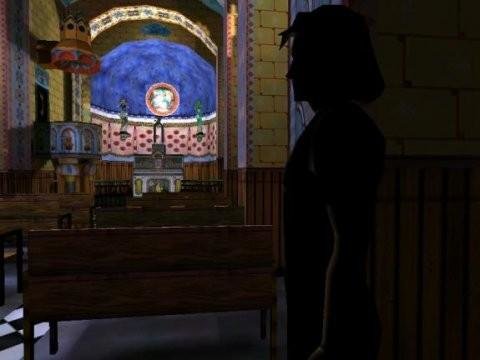
The last adventure ever to be produced by Sierra, and perhaps one of the most controversial both for its themes and unique style of play, Jane Jensen's Gabriel Knight III: Blood of the Sacred, Blood of the Damned is the most ambitious installment of the trilogy. Not only did it raise some highly contentious topics years before a certain Dan Brown, such as the possibility of the Holy Grail really being an allegory for the womb of Mary Magdalene, it also sought to reinvent the genre by putting players in direct control of the camera in a fully 3D environment. This feature allowed for an unprecedented amount of free exploration, though the success of the actual implementation is still a question of debate among adventure gamers.
What matters the most, however, is that even with a final cliffhanger that was clearly meant to be resolved in the next (as yet still unmade) chapter, this game is a masterpiece of interactive storytelling, a compelling example of what could still be achieved in a genre that was rapidly dwindling by 1999. The mesmerizing story of hidden secrets and mysteries, of blood and power, vampires and Templars, of lies that date back to ancient Egypt and earth-shattering truths about the progeny of Christ, features a solid cast of intriguing characters, all with an agenda of their own, and perhaps the best over-arching puzzle ever seen in an adventure, the multi-faceted Le Serpent Rouge. Even if a troublesome development history somewhat hampered the final product, as is occasionally evident in some ill-conceived design choices, the third and for now final chapter in the Gabriel Knight series remains one of the crowning storytelling achievements of all-time.
You might also like: Gray Matter, Memento Mori
#31 – Portal
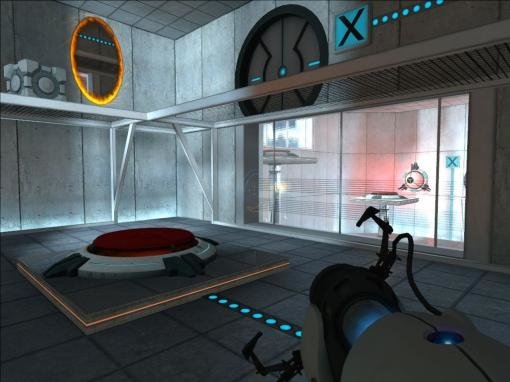
When Valve released The Orange Box, the inclusion of Portal almost seemed like an afterthought to the high-profile shooters it was bundled with. It wasn’t until we played through the short but sweet first-person physics puzzler that we realized this “afterthought” was arguably the best part of an already impressive package. The game features a simple enough premise: a silent protagonist finds herself in a series of mechanical test chambers with no clear goal except to reach the end. The only tool at your disposal? A unique gun that fires coloured portals instead of bullets, allowing you enter one and exit the other to surpass seemingly impossible obstacles. This completely different approach to puzzle design provides some of the most original challenges the adventure genre has seen in the last decade. If you dare to consider it an adventure – and we do, albeit a whole different type of adventure than any other.
As clever as its puzzles are, it’s the writing that makes Portal truly spectacular. The insane computer A.I., GLaDOS, is one of the funniest characters in or out of a computer game. Whether training you in how to use the portal gun, taunting you for failing, or enticing you with promises of cake, virtually every line GLaDOS speaks is entertaining, yet reveals a surprisingly complex character that hints of a much darker purpose behind your captivity. The rest of the story is told simply through observation of the environments themselves. Concealed rooms in broken walls feature drawings and scrawled writings from a deranged former occupant. Cloudy windows high in the test chambers hint at hidden observers you never see. And when you finally break through to the other side and see what’s really going on behind the scenes, it’s all the more effective because you’ve earned the discovery yourself. It’s classic Valve storytelling at its best. Hilarious and unique, Portal was a surprise hit of 2007 that every adventure gamer owes it to themselves to experience.
You might also like: Umm… playing it again?
Next up: #30-21...
#30 – Bad Mojo

Most adventure games whisk you through gorgeous, fantastical worlds full of dashing heroes and heroines. Not Bad Mojo. Pulse Entertainment’s 1996 adventure turns that notion on its beady, antennaed head, starring an ugly little cockroach that takes you for (hopefully) the most disgusting ride of your life. In this terrifically unique game, you “play” as Roger Samms, a weirdo with a bowl haircut living in a dingy little apartment above a dive bar. He seems to have stumbled across quite a bit of money and is ready to start the good life and get out of dodge. Only before doing so, he tries to pack up his mother's strange locket, and all of a sudden he's zapped into a cockroach. Yuck! Not a Kafka-esque, man-sized bug, either. You’re the real deal, and now even normal household elements are life-and-death struggles for survival – especially with no hands!
The arrow keys are used to maneuver poor roach Roger through different hazards like roach motels and hot stove burners to get to the bottom of what happened to him. It takes some getting used to, but you’ll soon be immersed in a world filled with hot bubbling dangers just waiting to extinguish you. You won’t gather inventory or solve traditional puzzles; rather, you’ll have to carefully determine how to make it across each dangerous landscape unscathed. But be forewarned: your skin may not stop crawling as you watch yourself skitter past dead rats and across a leftover TV dinner. Bad Mojo is definitely not for the squeamish, but if you can stomach the grotesqueries, exploring this suddenly imposing everyday world and solving puzzles is utterly fascinating from a roach’s point of view. Whether playing the original or the “Redux” version with updated video, you may not emerge from Bad Mojo with a newfound love of roaches, but the next time you see one, you may just have some grudging respect for its perilous adventure, having lived through a memorable one yourself.
You might also like: Dogday
#29 – Phoenix Wright: Ace Attorney

Capcom’s quirky Phoenix Wright: Ace Attorney took the adventure community by storm when it was released in 2005. Originally launched in Japan on the Game Boy Advance, the enhanced remake for the Nintendo DS introduced the endearingly nervous, spiky-haired defense attorney and made common household expressions out of his patented catch-phrases “Hold It!” and “Take That!” The rookie’s five cases involve investigating crime scenes personally before defending the accused against seemingly impossible odds in court against the brilliantly flamboyant prosecutor Miles Edgeworth. But real-world laws do not apply in a courtroom ruled by a clueless, gavel-happy judge, with compulsively lying witnesses allowed to change their testimonies at will. It’s all very strange, surreal, and utterly charming, with a brilliant new gameplay dynamic as well.
The investigative portions involve examining locations for clues and interviewing people to acquire evidence you can take to court. There it must be presented at just the right moment to support your theories or catch a witness fibbing. These court scenes essentially become complex dialogue puzzles as you sift through testimonies line by line, looking for weaknesses. You can press for more, call them on a suspected lie, or let the statement slide. But be careful! Mistakes have consequences – make enough and you can be sure a guilty verdict will come down. The backdrop to all this bizarre action is a delightful anime-style graphical presentation, with wonderfully exaggerated character gestures and expressions. The final case, exclusive to the DS remake, even makes clever use of the handheld’s unique features, which none of its sequels have matched. With its strong script, oddball characters and creative gameplay, Phoenix Wright: Ace Attorney can stake a claim as one of the genre’s best on any platform. Surely there is no objection.
You might also like: Ace Attorney series
#28 – Sam & Max Hit the Road

The world is a better place with Sam & Max in it. In this politically correct era of Disney ideals, we NEED a canine shamus and a hyperkinetic rabbity thing who don’t think twice about gutting a cat just to move the investigation on (in a totally comedic way, of course). The Freelance Police may have been internally assimilated in the company’s early days (starting life as test sprites for the SCUMM engine), but LucasArts took a big gamble in giving cartoonist Steve Purcell’s creations a full game all their own – quaint family hijinx these were not. It was a risk that paid off brilliantly, however, as the outcome was an amusingly surreal road adventure across the tourist back alleys of the US of A.
Released in 1993, the game looked similar to other titles of the time, but the humour was an entirely different beast. Purcell based the story on some of his early Sam & Max comics, fully expecting them to get toned down during production. Not so, thankfully, as Hit the Road is hilariously edgy from beginning to end. Complementing the excellent jazz-inspired score is some brilliantly bizarre dialogue brought to life by inspired voice acting. Rounding it all off was a big overhaul for the SCUMM engine, replacing the standard verb input method with a set of icons selectable by right-clicking – a feature still used in some adventures today. All these factors combined to make Sam & Max Hit the Road a riot, which is exactly how they’d like it. The pair have remained immensely popular over the years, with multiple sequels and even a cartoon television series, but for most of us, this is where it all began and it’s proven very hard to top.
You might also like: Edna & Harvey: The Breakout, Strong Bad’s Cool Game for Attractive People
#27 – Discworld Noir
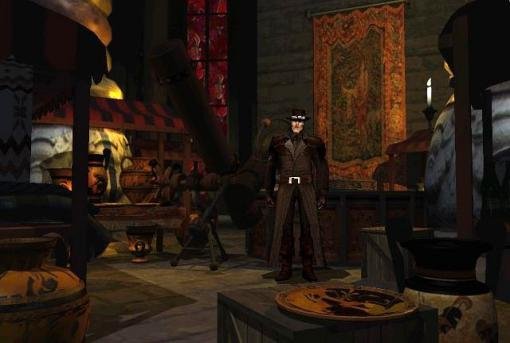
After two successful comic adventures based on Terry Prachett’s fantasy Discworld franchise, Perfect 10 Productions took the series in an unusual direction, with even better results. Discworld Noir is what you’d get if you mix a parody of classic film noir elements and a sprinkle of pure dark whimsy, set on this bizarre flat disc on the back of four elephants, who in turn ride on the back of a giant cosmic turtle. The Discworld’s first-ever detective is the hard-boiled, down-on-his-luck Lewton, whose life takes a turn for the crazy when he encounters the mysterious, seductive Carlotta Von Uberwald. As you help Lewton investigate an increasingly complex case, you’ll get to interact with some old Discworld favorites like Nobby, a corporal on the city watch who never gave up his old habit of stealing things when no one was looking, and new characters created specifically for this game, like Al Khali, a murderous dwarf who eschews the typical fine-toothed comb for an axe when searching Lewton’s office.
Surrounding these oddball characters are fantastic pre-rendered backgrounds that capture the dark, dreary city of Ankh-Morpork perfectly. You’ll explore the city’s seedy underbelly (well, as the Discworld’s largest city, it’s all seedy underbelly, so that’s a lot of exploring) for clues, which is another of the game’s strong points. Your tasks focus on detective work rather than typical inventory puzzles (though there are a few of those), and it’s a blast interviewing suspects, exploring a variety of locations, and gathering information. The game provides you with a handy notebook that doesn’t just keep track of clues, it lets you actually use them much like regular inventory. It's a common feature in adventures today, but this game was blazing that trail long before others caught on. Working as a private eye focused on gathering and manipulating clues to come to a solution is a perfect integration of gameplay and story. Whether you like detective stories, film noir, comedic fantasy, incessant rain, or blackmailing singing trolls, you can’t help but enjoy investigating the zany universe of Discworld Noir.
You might also like: Culpa Innata, Emerald City Confidential
#26 – Heavy Rain
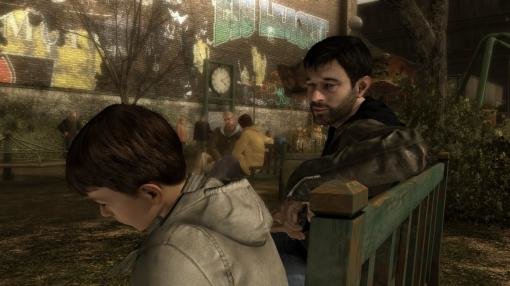
It all started with a tech demo, showing a teary-eyed woman berating the player with accusations of infidelity and abuse. Quantic Dream showed they had come nearer to leapfrogging the Uncanny Valley as anyone could have imagined in 2005. Four years later, it came to fruition in Heavy Rain, an innovative, experimental adventure game on a console dominated by shooters and RPGs. Building on the work begun in Indigo Prophecy/Fahrenheit, the French developer pushed the envelope in visual fidelity, cinematic presentation, and branching story paths where the player’s actions truly matter. Freedom of choice is hardly a new concept, but rarely (if ever) has it been pushed to these extremes with such impressive results. Heavy Rain even managed the unthinkable: it made Quick Time Events fun. Now that is an accomplishment.
There are four storylines in Heavy Rain, each involving a different main character, including a father grieving over the loss of one son and driven to action by the kidnapping of another, an FBI profiler with sci-fi sunglasses to analyze clues at crime scenes, a private eye, and an investigative journalist, all pursuing individual leads into the identity of the serial Origami Killer. Rarely do the characters interact with each other, but their narratives cleverly interlock to provide an intriguing whole. Each protagonist is given real depth of character that allows you to identify with them, making you all the more invested in their fates. Their stories all depend heavily on the player's choices, successes, and failures, and results can vary wildly, making one playthrough truly unique from another. If one of them dies, the story even plows forward without them. At times it feels more like a movie than game, but when it comes to taut, emotionally-charged, player-directed thrillers, Heavy Rain is better than perhaps any game ever made.
You might also like: Voyeur series, Tender Loving Care
Next up: #35-31...
#25 – Tex Murphy: Under a Killing Moon

The first two Tex Murphy games had their fair share of problems, from the dreadful speeder sequences in Mean Streets to the lacklustre story of Martian Memorandum. Then in 1994, Under a Killing Moon became the first installment (and first adventure of any kind) to introduce what would become the hallmark of the series: free exploration through pseudo-3D environments, interspersed with tons of full-motion video sequences. With a host of Hollywood acting talent, branching dialogues, a context-sensitive hint system, substantial puzzles to solve, and Aaron Conners on board to help Chris Jones author its engaging sci-fi mystery story about a dangerous cult seeking to bring forth the Apocalypse, the combination proved to be a winning formula that was far ahead of its time. (In fact, it’s still far ahead of most games today!)
Of course, being a pioneer meant that Under a Killing Moon is not perfect, and indeed many sequences can be a bit frustrating, especially when fast reflexes and hand-eye coordination come into play. Still, the puzzles are nicely integrated into an intriguingly layered detective story, with dozens of interesting characters, ranging from disfigured mutants treated as pariahs by the rest of the population to treacherous femmes fatales dressed in black, always with a cigarette between their red lips. The 3D environments have not stood the test of time particularly well, but the atmosphere has lost none of its appeal, paving the way for this game’s inclusion on the list of all-time greats. Playing Under a Killing Moon is like reading a sci-fi version of the best Raymond Chandler novel, and Tex himself (played superbly by Jones) is such a lovable, charismatic lead that he deserves a rightful spot amongst the greatest heroes of the adventure genre.
You might also like: Tex Murphy: Overseer, Dark Side of the Moon
#24 – Police Quest 2: The Vengeance
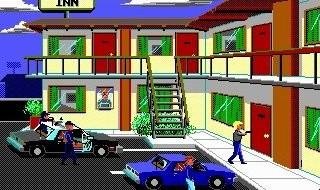
At a time when cartoon comedies and light fantasy adventures ruled the genre, the gritty realism and intrigue of Sonny Bonds and the Lytton Police Department provided a captivating change of pace that was never more perfectly realized than in the brilliant Police Quest 2: The Vengeance in 1988. The story takes a direct cue from the conclusion of the first game in the series, continuing the tale of the “Death Angel” Jesse Bains one year after his capture. The sequel takes no time at all to ratchet up the intensity and never lets up on the suspense through pursuit, multiple murders, and a violent final confrontation in the underground sewers of a fictional New Mexico city.
The other Police Quest adventures suffered from thin plotting and weak writing, but this gem has no such issues, with a great script and a very balanced level of difficulty. Sierra really set a new standard of drama for the time, with some surprising turns and the violent integration of elements of Sonny’s personal life. The game is colourful and diverse in its locations, offered a sparse but cool soundtrack in the earliest stages of the sound card, and in all areas it boasts a remarkable attention to detail that makes the game a wonderful detective mystery. As one of the top games – serious or otherwise – of its era, The Vengeance is still an entertaining and intense adventure more than two decades after its release, standing not only as the best of its series but one of the very best of the genre all-time.
You might also like: Police Quest series
#23 – Quest for Glory IV: Shadows of Darkness
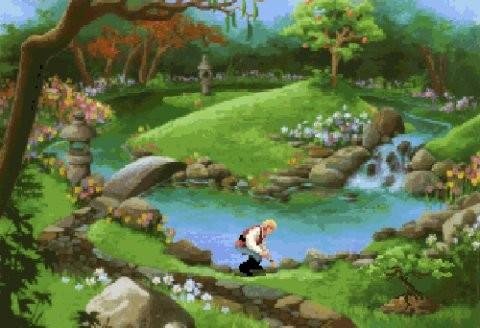
Arguably the best chapter in the Quest for Glory series (we know, because we argued), Shadows of Darkness overcame a huge array of bugs that plagued the initial release to stand alone atop this unique RPG-adventure hybrid series. As a bonus, most of the bugs have since been resolved by fan-made patches, providing a better experience all around. But even back in 1993, its gorgeous VGA backgrounds literally oozed atmosphere from every pixel, and an outstanding soundtrack accompanied every moment of the game with haunting, memorable instrumental pieces. Then there’s the usual series trademark, that exquisite mix of adventure gameplay and RPG features, like character-building, side-quests and – gasp! – even combat (though here you can let the computer A.I fight for you if you wish).
Most notable of all, however, is the deeply touching story about regret and redemption, whose Gothic elements perfectly fit with the Transylvanian setting and mythology, and the many endearing characters – some solemn, some zany, but all of them vibrant and charming in their own ways. This includes not only one of the greatest all-time "villains" of the genre, but also minor characters like Tanya and Toby, whose tale is bound to bring at least a little tear to the eye. Then, of course, honourable mention must go to Jonathan Rhys-Davies, who did a mesmerizing job as the voice of the narrator, delivering an ominous tone to every description, making the experience all the more exhilarating. The sum total of these superb elements make Shadows of Darkness the most memorable installment in the one-of-a-kind Quest for Glory series and one of Sierra’s finest achievements overall.
You might also like: Quest for Glory III-V
#22 – The Lost Files of Sherlock Holmes: The Case of the Serrated Scalpel
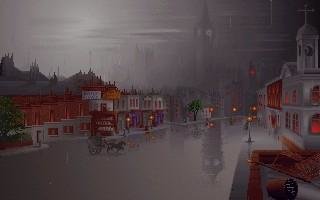
Ask anyone about good detective mysteries, and the name Sherlock Holmes springs immediately to mind, and for longtime adventure gamers, The Serrated Scalpel usually stands out as his greatest triumph. Mythos Software’s 1992 Lost Files game tells a brilliant, original tale in which Holmes is confronted by a murder that appears to be the work of Jack the Ripper. He knows better, however, and this certainty sets him and his ever-faithful partner Dr. Watson on a chase across London to find the real culprit. The ambitious plot twists and turns in unexpected ways, cleverly involving a cast of over a hundred across more than twenty different locations, from the morgue to the London Zoo. There is so much to investigate and so many people to interrogate, the plot feels incredibly meaty and will keep you hooked for quite some time.
The faithfulness to the Sherlock Holmes canon is also evident, with many familiar characters making appearances, plus nice little references to other cases that only fans of the books may notice. But even Sherlock neophytes have found themselves completely engrossed by continually uncovering clues that create new leads that point to new places with still more clues to find. The plot progression feels very organic, and though challenging, it is a lot of fun piecing together the evidence to work out the truth. The sound design and graphics were nothing special at the time of release, and there are technical limitations that prevent it from holding up well two decades later. But if you can find a copy and get it running, even now you’ll feel like you’re actually in an authentic Sir Arthur Conan Doyle mystery, which raises it above even the slicker, newer Sherlock Holmes adventures of today.
You might also like: The Lost Files of Sherlock Holmes: Case of the Rose Tattoo
#21 – Blade Runner

Though history may remember them best as the creators of the critically-acclaimed strategy series Command & Conquer, Westwood Studios made a fair number of adventure games in its time, including the brilliant 1997 companion to Ridley Scott's 1982 dark future masterpiece, Blade Runner. Taking place parallel to Rick Deckard's investigation, the game stars rookie Blade Runner Ray McCoy, who explores many of the film's signature environments and interacts with familiar characters as you hunt down a group of replicants who are suspected of killing real animals. Given their scarcity in this grim, neon-obsessed metropolis of 21st century Los Angeles, this is a crime on par with murdering humans. The storyline twists and turns continually, and you’ll come to suspect virtually everyone of being a “skin job”. Even your own authenticity comes into question.
The game was originally billed as a “real-time adventure game” and employs a variety of sequences that test your reflexes against other characters and environmental hazards along the way. You will dodge a screaming maniac, examine crime scene photos with the ESPER, and administer Voight-Kampff tests to suspected replicants you encounter. The story boasts a large number of branches, both in the final moments and in multiple steps along the way. If you like, you can mimic the plot of the movie or take the investigation in a vastly different direction. No matter which of the many narrative alleys you venture down, the game manages an engaging story with well-realized characters and subplots that build on, never break, the reality established in the classic film. As a bold movie tie-in (albeit 15 years after the fact), Westwood gave players both the world they were familiar with and the personal agency to explore it as they saw fit, securing Blade Runner its rightful place among adventure gaming's best.
You might also like: Nightlong: Union City Conspiracy, DreamWeb
Next up: #20-16...
#20 – Still Life
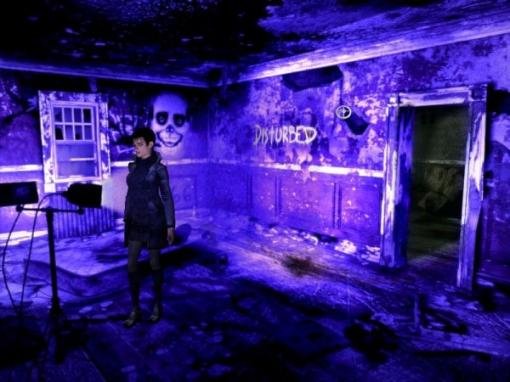
Gritty. Disturbing. Dark. Still Life, Microïds’ fabulously grim follow-up to Post Mortem, follows FBI agent Victoria McPherson in modern day Chicago, and her private detective grandfather Gus McPherson (star of the original game) through flashbacks in 1920s Prague. From its stylish cinematics splattered in blood to the gruesome crime scenes to investigate, Still Life immerses players in an adult-themed story of murder, family, seduction, and art, as Gus and Victoria both track down a very similar series of brutal homicides. Atmospheric graphics that paint a disturbing picture of a serial killer who preys on and viciously mutilates lost souls forgotten by society blend with a phenomenal musical score, pumping techno tunes in Chicago and haunting carnival strains in Prague, helping set the game’s richly sinister tone.
Both protagonists are impressively fleshed-out: Gus, a man haunted by murders from his past, and Victoria, an agent wearied by the daily horrific grind of a crime-ridden city. Though the settings and storylines are vastly different for each character, the gameplay remains rooted in real-life logic. Enter a crime scene and you’ll simply take note of objects and clues; it’s not until you obtain forensic tools that you’ll fully interact with them. Locking puzzles aren’t just strewn around to draw out play time; you’ll encounter them only when it’s time to secretly infiltrate new areas in your investigation. Logical puzzles, haunting animations, complex characters – what more could you ask for? Well, a sequel from the same talented development team would have been nice. If there’s one major blemish on this otherwise stellar crime thriller, it’s the cliffhanger ending that teases more than it resolves. Alas, after the French Canadian studio shut down, a lacklustre follow-up by a different developer showed just how compelling the original was by comparison, superbly managing to breathe life into a story drenched in blood and death.
You might also like: Post Mortem, Still Life 2
#19 – Beneath a Steel Sky

Revolution Software has built its reputation largely on the Broken Sword franchise, so it can be easy to forget the wonderful game that put the company on the adventure roadmap, 1994’s Beneath a Steel Sky. In a dystopian, cyberpunk-flavoured future ruled by computers and corporations, Robert Foster must discover why he has been dragged from his home in the harsh outworlds into Union City, and why the LINC computer that controls the city has apparently saved his life. The story is a remarkable blend of cold, sometimes chilling, science fiction with a brilliantly dry sense of humour – often topped off with a bit of genuine emotion, whether from your robotic sidekick Joey (possibly the best sidekick in the genre’s history) or from the family dynamics that play into the incredibly moving ending.
A game of this great size and scope resulted in an arduous and stressful production process for its small developer at the time, but the fruit of their labour is still an enjoyable adventure experience today. The dialogue is uniformly brilliant, the voice acting is top-notch, the art is colourful and vibrant (especially the beautiful introductory comic sequence, drawn by Watchmen creator Dave Gibbons, who also drew the game’s gorgeous backgrounds), and the entire experience feels like a true genre classic. Better yet, the game has been legal freeware since 2003 and is now available in iOS formats as well, ensuring there will never be any excuse for adventure fans not to play this landmark game.
You might also like: Broken Sword series, The Moment of Silence
#18 – Myst
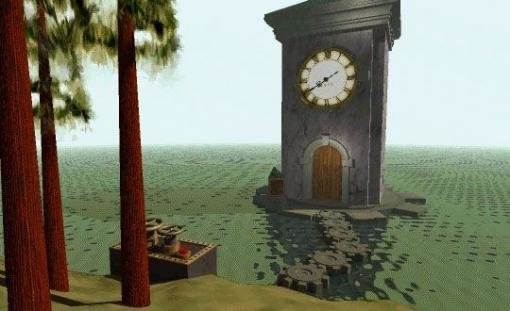
Perhaps the game most guaranteed to produce a strong love-or-hate reaction amongst adventure fans, Myst first arrived back in 1993, and has delighted and dumbfounded in equal measures ever since. For many years, this adventure from Cyan Worlds was the best-selling PC game of all time and helped usher in the era of CD-ROMS. Beginning on a surreal island in the role of an unnamed stranger, players are required to unearth four books that link to completely new “Ages” dreamed up by a man named Atrus. But something has gone wrong. Through two other books, Atrus’s two sons claim that their father has been killed, each blaming the other and asking you to retrieve their missing pages and set them free. Which to trust? Only by visiting the other worlds can you hope to piece the true story together.
With its simple but effective first-person slideshow presentation, Myst was one of the first games to create a world that not only looked real but felt alive. Its four Ages (and Myst Island itself) provide diverse settings to explore, with virtually no plot or direction pointing the way. Instead, there are a series of logical, interrelated puzzles to complete, with objects and information discovered in one Age sometimes required to solve puzzles in another. Depending on which order you visit the Ages, this makes the puzzles feel either ingenious or frustratingly complex – or both, depending on your perspective. The solitary exploration, non-linear gameplay, and absence of any guiding narrative are what make the experience so divisive, but no matter which side of the fence you’re on, with numerous ports and a proliferation of so-called “Myst clones” over the years, there’s no denying the game’s tremendous impact on the genre.
You might also like: realMYST, Myst V: End of Ages, Uru: Ages Beyond Myst
#17 – Machinarium
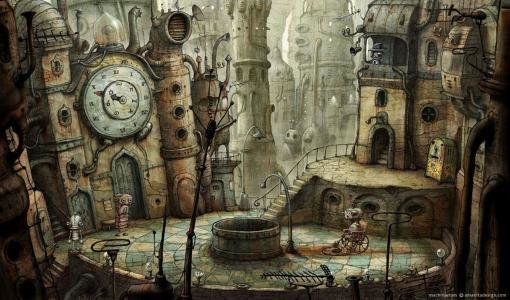
Amanita Design made waves in 2003 with Samorost, a peculiar, minimalistic point-and-click adventure playable for free from a browser. It merely teased of the designers’ enormous potential, however, and we longed with anticipation to see what the indie Czech studio could do with a bigger budget and a full-scale adventure. We finally got our wish in 2009, and Machinarium immediately became both a commercial and critical darling. In a sweetly amusing story conveyed entirely through pictographic thought bubbles and on-screen action (there is no dialogue, written or spoken), a recently-scrapped robot must find his way back into a rusting metallic city to foil the bomb plot of a gang of criminals, win the robo-girl and save the day. Cute anthropomorphic robots are hard to screw up, but they're equally hard to master, yet Amanita has made a masterpiece that’s charming in ways that few other (if any) games can match.
Despite the grungy mechanical backdrop, Machinarium’s beauty is a wonder to behold. Entirely hand-drawn, the game's characters and backgrounds are truly jaw-dropping creations. Every scene is a work of art, its own reward for progression, as each decaying detail in this surreal world is carefully orchestrated and designed, inhabited by a cast of automatons that make it feel like a robot fairy tale awash in a muted colour palette. The gameplay is an ideal marriage of simplicity and complexity, its puzzles often involving manipulating environmental Rube Goldberg-esque contraptions, yet rarely becoming overwhelming or confusing. The brilliantly eclectic soundtrack is a relaxing mélange of minimalist electronic, glitch-pop, ambient, and even the odd bit of folk. Really this is a near-perfect game, succeeding on almost every level, and the sheer amount of polish applied at every stage of the presentation makes Machinarium truly exceptional.
You might also like: Puzzle Bots
#16 – Gabriel Knight: Sins of the Fathers
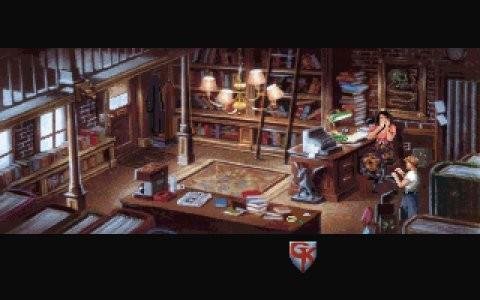
When Jane Jensen approached Ken Williams with her ideas for a new adventure, many were skeptical about the chance of success for such a dark, grim tale of guilt, horror and loss. Of course, time proved all doubts wrong, as the first title in the Gabriel Knight series was an instant hit and is now frequently hailed as one of the highlights of the genre’s glory years. Sins of the Fathers introduced the beloved titular character, a down-on-his-luck novelist who owns St. George’s bookshop in the French Quarter, and his assistant Grace, a student spending the summer in New Orleans. Gabriel is plagued by nightmares as he investigates a string of ritual murders supposedly connected with voodoo, and his journey of self-discovery ultimately spans three continents and changes him forever. Powered by a slightly more complex version of the SCI engine seen in Sierra’s earlier VGA titles, Sins of the Fathers amazed players with its engrossing storyline that didn't shy away from mature themes.
Enriched by a lively supporting cast of fleshed-out characters, some of whom returned in the later series sequels, it's easy to see why the game holds such a special place in the hearts of countless adventurers around the world. The abundantly detailed backgrounds, from the Louisiana swamps to an ancient, tumbledown European castle, are gorgeous even today; the soundtrack by Robert Holmes is both evocative and haunting; and the puzzles are well thought-out and seamlessly integrated with the storyline, making players feel like real occult detectives. Last but certainly not least, the top-notch writing, highlighted by the beautiful poem whose verses open each new day, is among the best ever seen in a computer game. And unlike earlier Sierra games, no unpredictable dead ends mire the flow of the tale, resulting in an experience that is as powerful today as it was in 1993.
You might also like: Blackwell series
Next up: #15-11...
#15 – Syberia

Microïds’ Syberia introduced gamers to a stark wonderland of mechanized beings and childlike wonder in the 2002 release from acclaimed designer Benoît Sokal. Representing her employer's takeover of a toy factory in a remote French village, corporate lawyer Kate Walker discovers the person she was sent to find has passed away and that only a single heir can sign off on the deal. The simple task of locating him turns into an adventure of epic proportions when she discovers the man she's after has abandoned his former life in order to seek out the titular realm where mammoths are rumoured to still exist. As Kate follows the eccentric but brilliant inventor’s obsession, she enters a magical world of talking robots, an elaborate wind-up train, an oppressed opera singer, and a slew of fantastic creations. The most important discovery on her journey through a world of wonder and dreams, however, is herself.
Noted for its lush visuals, colourfully eccentric characters, and immersive character-driven story – all of which are qualities that stand up to this day – the game's lasting impression was ensured right out of the gate. Everything from the jaw-dropping art direction to the rich sound design bring the world of Syberia to life, building a sense of wonder and hand-painted beauty that hadn't been seen before, and arguably hasn’t been matched to this day. Though criticized for its ease and lack of interactivity, the melancholic atmosphere enveloping these living postcards was almost palpable for those who took the time to absorb it. Initially released for PC only, the game was ported to the Xbox, PlayStation 2, and later to iOS and Nintendo DS, though the PC remains the best platform for truly admiring its incredible graphics. Benoît Sokal crafted a true masterpiece in Syberia, showing the emotional power adventure games can have, setting the bar so high that few (including its own sequel) will ever be able to equal.
You might also like: Amerzone, The Whispered World
#14 – The Secret of Monkey Island

LucasArts’ Monkey Island franchise is perhaps the brightest shining star of the comic adventure genre, with Guybrush Threepwood its poster pin-up. Many players’ love of adventure games began with The Secret of Monkey Island, though it’s hard to believe it was released way back in 1990 when the SCUMM engine was in its infancy. Ron Gilbert’s brainchild helped kick-start the Golden Age of adventure games that would happily continue until the late ‘90s, including several sequels of its own. The public lapped up the hapless Guybrush's bumbling attempts to become a mighty pirate and oppose the ghostly villain LeChuck, which set the mould for other LucasArts adventures to come and gave the Monkey Island franchise a rock-solid foundation to build on.
What resonates most with players even today is the hilarity of the game – who can forget insult swordfighting, Stan the used-ship salesman or the piranha poodles? But it is so much more than that. Its puzzles are challenging, the tale is a surprisingly touching love story across the high seas, and Guybrush is an eminently likeable dreamer that we all relate to inside. And that’s not even probing the game's technical prowess, like the revolutionary facial art implemented during conversation or the complete overhaul of the SCUMM engine from its clunky beginnings to something far more intuitive and user-friendly. Everything felt like a breath of fresh sea air for the genre at the time, and even two decades later, the recent Special Edition makeover and episodic revival prove there’s still life in the old sea dog yet.
You might also like: Tales of Monkey Island, Escape from Monkey Island
#13 – King's Quest VI: Heir Today, Gone Tomorrow

The original King’s Quest may have made the list mainly due to its historical importance, but King’s Quest VI: Heir Today, Gone Tomorrow is an excellent game that deserves a much higher placement on quality alone. A collaboration between series creator Roberta Williams and fledging designer Jane Jensen (who went on to dream up Gabriel Knight), King’s Quest VI retains the familiar fairy tale feel while introducing gameplay that’s better integrated with the storyline and more complex, personal stakes for the characters. Upon its 1992 release, the game showcased Sierra at its best – after a decade of innovation and evolution – and the company’s subsequent floundering and ultimate downfall over the following decade makes the magic of Heir Today, Gone Tomorrow all the more bittersweet.
Perhaps the most striking innovation at the time was its branching storyline. Partway through the game, the player makes a simple choice that determines whether Prince Alexander will reach the ending via a shorter, simpler path, or if he’ll experience the longer, more satisfying conclusion. This isn’t simply a matter of swapping out cutscenes; the puzzles and story progression are completely different after the branch point. King’s Quest VI was also one of the first so-called “multimedia” games, making good use of newly-available CD-ROM drives with a cinematic opening movie, high-resolution character portraits, and voiceovers that included Hollywood actor Robby Benson in the role of Alexander. When it came out, this game didn’t just exceed expectations, it set a new quality standard both for storytelling and production values. And thanks to its timeless love story, lush hand-painted graphics, and solid point-and-click gameplay, it’s still every bit as enjoyable twenty years later.
You might also like: King’s Quest IV, V and VII
#12 – Zork Grand Inquisitor

While Zork may be best known for helping pioneer the genre with its early text adventures, the franchise’s best actual game was saved for last. After a brief foray into darker themes in Nemesis, the series wisely returned to its more oddball Zorkian roots for its swan song. And this 1997 adventure is a treat from start to finish. And by “start” we mean even the creative Frobozz Electric Installer that delightfully sets the stage for the zaniness to come. As you attempt to topple the megalomaniac Grand Inquisitor, who has forbidden all use of magic in his iron-fisted rule, you’ll see classic locations in living colour for the first time, from the little white house to GUE Tech to Flood Control Dam #3. Along the way you’ll encounter a bearded fish with a unicorn horn, a be-bop-singing home security vine, flickering and bickering torches, and an inflatable sea captain. And you can always count on being eaten by a Grue. It’s a rich, imaginative fantasy world unlike any other, the likes of which we arguably haven’t seen since.
Although played in first-person as the infamous AFGNCAAP, the Ageless, Faceless, Gender-Neutral, Culturally Ambiguous Adventure Person, Grand Inquisitor is anything but a lonely game. You’re accompanied throughout by the wisecracking former Dungeon Master Dalboz, now trapped inside a lantern, and you’ll briefly get to control three helpers with unique gifts: Griff, the harmless pint-sized green dragon; Brog, the dim-witted but lovable blue troll-thing; and Lucy Flathead, a human female with lots of spunk, a funky hairdo, and an impressive heritage. Despite being outlawed, magic plays a major role in the puzzle design, as you must master a variety of off-the-wall spells like turning purple things invisible and making yourself more attractive. It may have marked the tragic end of Zork when it was done, but with the finale's combination of superb artistic design, whimsical humour, memorable characters, creative gameplay, and a terrific variety of fun puzzles, the venerable series certainly went out on top.
You might also like: Return to Zork, Death Gate
#11 – Indiana Jones and the Fate of Atlantis

Creating a game based on a beloved film franchise is a risky proposition, as evidenced by then-Lucasfilm’s varying level of success with the Indiana Jones movie tie-ins prior to 1992. But with no more silver screen releases on the horizon, the company branched out further with an entirely original story in The Fate of Atlantis, and the result still stands up as one of the finest adventure titles ever made. The tale sees Indy and associate Sophia Hapgood searching for the mystical lost city of Atlantis on a globe-trotting quest through dangerous situations, meeting a variety of dubious characters along the way. The game is much more dramatic than other LucasArts games of that era, but it's still sprinkled with humour and even creates some real romantic tension between the two leads.
Without the restrictions of a movie plot, the designers let their creative juices run wild, to great effect. It isn’t only the writing that stands out though, as the action sequences are truly exciting without ever straying from their point-and-click genre foundation. There is no Harrison Ford, but the title features an excellent voice cast and a rousing musical score that backs up the impressive visuals and groundbreaking cutscene animation for the time. Better yet, the game can be completed in three separate ways, using teamwork, wits or fists. The chosen paths are so different, it is almost like three full games in one, making this one of the most replayable adventure games ever. And with all the snappy dialogue, compelling puzzles and fun action to experience, most players are more than happy to start the epic journey again. Alas, The Fate of Atlantis was the last pure adventure for Indy, but it's a whip-cracking good time even today.
You might also like: Indiana Jones and the Last Crusade, Lost Horizon
Next up: #10-6...
#10 – Portal 2

Valve faced a monumental task when it chose to make a full-length sequel to the brilliant physics-based puzzler Portal. With such a hard act to follow, would the second game be able to live up to the near perfection of the original? Would the premise and style of the first game, a perfect fit at just a few hours, be able to sustain itself across a game more than twice that size? Would the portal gun gimmick or GLaDOS’s sociopathic yet amusing monologues start to feel repetitive? These questions were decisively answered in 2011 with Portal 2: Yes, absolutely, and a resounding no! A follow-up that surpassed the original seemed impossible, but in retrospect the first game was really just a warm-up for the main event. A wider variety of environments and tools, the inclusion of more memorable “characters”, and vastly improved visuals made the ongoing attempt to escape Aperture Labs feel just as fresh and even more exciting than the first time around.
While Portal was essentially a running tutorial much of the time, Portal 2 is the full game it was preparing us for, though not without some additional training for all the new toys like light bridges, liquid goo and catapults that were brought into play. The longer game time allows the puzzles even more space to gradually grow and increase in complexity. An impressively challenging co-op campaign was added, allowing players to experience portals in a whole new way, this time with friends. It’s hard to think of anything the sequel didn’t improve. GLaDOS naturally returns, and the new characters manage to be almost as amusing , which isn’t surprising as they’re voiced by Stephen Merchant and J.K. Simmons. And revelations about the history of Aperture Science and GLaDOS herself make the whole experience that much more intriguing. Valve seems unable to set the bar so high they can’t leap over it themselves, and Portal 2 is a testament to that. It’s nothing like any adventure you’ve every seen, but it’s a must-play for fans of any genre, and an instant classic that propelled its way right into our top ten.
#9 – Tex Murphy: The Pandora Directive
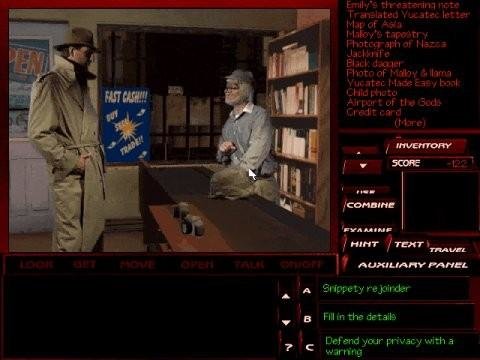
Many adventure games follow a straightforward path: there's a beginning, a middle and an end, with no place for player choices and their consequences. Even in games that offer multiple endings, it's almost always a matter of a very clear crossroad near the end. But The Pandora Directive proved to be so much more advanced in 1996. In fact, the fourth installment of the Tex Murphy series (though only the second to use the now-familiar FMV/3D exploration style) ensured that every single choice – even the most seemingly unimportant – truly matter. As a result, the outcome of each player’s adventure varies greatly depending solely on the choices you make, ranging from a satisfying ending that sees our hero triumph and win the heart of his lady to a grim, hopeless and depressing conclusion in true film noir fashion.
Back in the trench coat, fedora, and gumshoes of the titular detective, you must decide: will you be a jaded, cynical PI or will you play nice and be a gentleman? How will you treat the various women that gravitate around Tex? And what about Chelsee? Will you be faithful to your blossoming romance with her? Will you answer the phone or will you pretend to be outside? The many options present a deeply engrossing and incredibly rewarding experience. Penned once again by Chris Jones and Aaron Conners, this sprawling masterpiece about a government conspiracy concealing aliens allows you to role-play Tex as you like, and every finale is definitely worth exploring. Add to the mix some challenging puzzles, a vast live-action cast brought to life by some great performances, dozens of 3D locales full of nooks and crannies you can thoroughly explore, and The Pandora Directive did what seemed impossible only two years earlier: it beat its own accomplished predecessor at its own game.
#8 – Monkey Island 2: LeChuck's Revenge
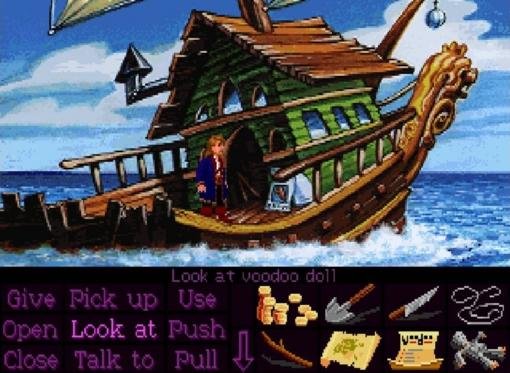
How do you follow up one of the most popular comic adventure games of all time? If you’re LucasArts circa 1991, you make an even better one. While still a comedy with plenty of laughs, Guybrush Threepwood’s second outing is a slightly darker affair than its predecessor. He is a more mature adventurer this time, a fact reflected in the tone and art style of the game. Voodoo torture with agonizing animations is commonplace, and the ghost pirate LeChuck is at his scheming worst in his quest for revenge against Guybrush, now seeking the legendary Big Whoop. The changes didn’t hold back the public though, as the game was massively hyped by the mainstream press and lapped up en masse at the time of release.
And rightfully so! The sequel is a fantastic game: insults, spitting contests, voodoo – what's not to love? Well, the hugely controversial ending for some, though for others it’s just another jewel in its crown. Retaining much of the same crew that worked on The Secret of Monkey Island, it improved on its predecessor in almost every way. The graphics were gorgeous and really brought to life the characters we’d already come to love, the SCUMM engine was even more refined, two different difficulty levels were offered, the first-rate story featured puzzles that required plenty of thought but no frustration, and the innovative music was top-notch. When it comes to comic adventures, you can’t get much better than Monkey Island 2. It’s no surprise that like its older brother, its recent remake is appealing to a whole new generation of gamers all over again.
#7 – The Last Express
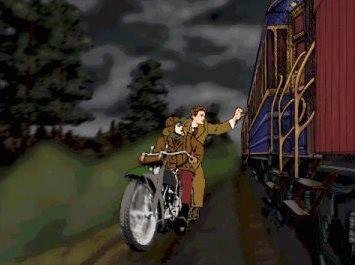
Where do the accolades start for Smoking Car Productions’ The Last Express? Is it the rotoscoped graphics that give the game a uniquely classy sense of style? Is it the painstaking historical recreation of the final voyage of the Orient Express before World War I? Is it the stunningly immersive real-time progression of gameplay? Or is it the thrilling and extraordinarily literate writing? Why choose? There really isn't anything quite like Jordan Mechner’s 1997 adventure. While the story of American doctor Robert Cath and the international intrigue he encounters on a train journey from Paris to Constantinople does head to some pretty fantastical places, it is equally balanced by a genuine sense of realism and authenticity. Mechner's team went to great lengths to portray everything from foreign languages to daily weather patterns with historical accuracy. The characters portray the broad and tumultuous sociopolitical climate of the era, as Cath encounters everyone from German businessmen to Serbian militants. And in a still-unparalleled design decision, live actors were filmed and then hand-traced in a style reminiscent of early 20th century illustration.
Making things feel even more authentic is the game’s real-time progression: The Last Express doesn't wait for you. The train barrels relentlessly toward Constantinople, stopping at several famous locales along the way. Similarly, the other passengers have their own agendas to attend to; they move around the train, have conversations, go to sleep, eat dinner, conduct secret meetings, and so on. As Cath, players have more or less total freedom to explore the train and observe, interact with fellow passengers, or sneak around trying to find information. This gives the game an astounding level of replayability for an adventure game, since you'll never be able to see everything in a given playthrough; while you're off exploring one car, something else (something probably very interesting) is going on in another. And if you don’t like the direction your recent choices have taken, rather than simply restore an old save file, simply rewind time and begin that segment of the journey all over again. It all adds up to a tense, immersive, and innovative adventure that few other games have equaled.
#6 – Day of the Tentacle

When LucasArts’ Tim Schafer and Dave Grossman were given an opportunity to continue Ron Gilbert’s Maniac Mansion series in 1993’s Day of the Tentacle, they attacked that goal with a completely unhinged sense of whimsy and irreverence for American history. The extraordinary result was a legacy of hilarity that made genre immortals out of bookish Bernard, rocker Hoagie, and ditzy Laverne, setting new standards (yet to be matched decades later) for comedic puzzle design in the process. Although once again featuring three playable characters, the game marked a radical departure from its predecessor, reinventing the franchise as a story of unlikely heroes spread out across 400 years of past, present, and future times in an attempt to stop the insane Purple Tentacle from ingesting toxic sludge. Filled with quirky charm and outlandish scenarios, this game has it all, from a frozen hamster to fake barf to a flushable inventory-swapping Chron-O-John.
The game succeeds on every significant level – a unique and beautiful art style that defines “cartoonish” perspective; spectacular voice acting across the board that exponentially increases the quality of the already-brilliant dialogue (at a time when the CD-ROM was still a relatively new luxury); ingenious puzzle design, featuring most of the greatest time-travel puzzles ever designed; and a phenomenal attention to cinematic detail that can only be described as “Schafer-esque.” It begins with what is still the only comedy adventure game intro that truly feels theatrical, and the final shot before the credits roll is the perfect payoff. It is hard to find enough superlatives to describe a virtually flawless game – Day of the Tentacle was and for now remains the greatest comedy adventure ever.
Next up: #5-1...
#5 – Riven

Cyan's Myst may have been a revolutionary game, but the masterful Riven proved its superior in every way, delivering an unrivalled depth of visual realism, puzzle integration, and organic storytelling. In 1997, the sequel once again thrust players into the boots of the stranger, this time to help Atrus by rescuing his wife Catherine from his estranged father Gehn, who has imprisoned her on a dying world. The premise may be thin, but Riven is a far more complex, unified set of islands, and it’s a marvel just to explore its lakes, volcanic cliffs, and beaches, much of which you can reach without ever solving a puzzle. You can sneak up on sea creatures lazily sunbathing on the rocks, or watch an irritable giant fish through an external viewer. Although largely deserted, you’ll find plenty of evidence of D’ni civilization as well, complete with mechanical lifts and interconnected tram rides. In making your way through these serene but troubled lands, Riven is as much an unguided tourist experience as it is a game.
The Age of Riven is not only bigger and more beautiful than its predecessor’s, it’s also much, much harder. Puzzles are often multi-layered, requiring several steps to solve completely. With unique writing and numbering systems and myths to learn, all without any overt assistance, note-taking is essential. Anything can be a clue, requiring the utmost attention to even the smallest of environmental details, both visual and audible. Those subtle but richly immersive sound effects aren’t just for ambience; they’re an inherent part of the islands that factor into the puzzles as well. Taken alone, the game’s qualities are exemplary, but it’s the brilliant interweaving of each element that makes it a timeless classic. Striking a near perfect balance of difficulty and design, Riven is definitely not for the puzzle-solving faint of heart, but for anyone who enjoys an engrossing challenge, Riven is an unforgettable work of art.
#4 – Broken Sword: The Shadow of the Templars
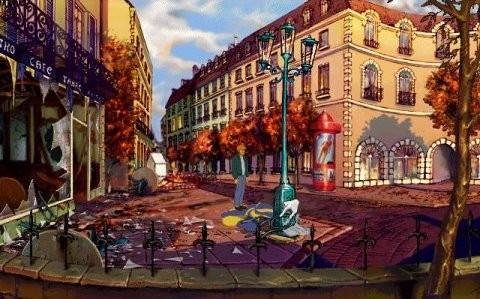
Few companies were able to go toe-to-toe with LucasArts and Sierra back in their heydays, but Revolution, a tiny British company, not only released a worthy rival in 1996, but one so outstanding that it outshone all of its contemporaries at the time – and most since. Broken Sword: The Shadow of the Templars was that game, and it did just about everything right, from the memorable European settings to the expansive globetrotting plot to the gorgeous cartoon graphics. In particular, its lead character George Stobbart proved to be a runaway success – a lovable everyman thrown into a situation we’d all secretly love to experience. It's a nice play on the standard Indiana Jones-style story, but George has more in common with Guybrush Threepwood than the bullwhip-slinging adventurer.
George is far from alone, however, as the game features a memorable cast of supporting characters as well, including the perfect foil in Nico, the sassy French photojournalist. The story builds from a single random event (a coffee shop being blown up by a clown) to a much larger, deadly plot involving conspiracies, secret orders, and the Knights Templar. Add in some brilliant voice acting, a touch of humour, and a host of clever puzzles and you’ve got adventure gaming gold. It put Revolution on the map and made gaming royalty out of its designer Charles Cecil, a man who now holds a royal honour for his work in the British Gaming Industry. The game has spawned three sequels and has stood the test of time so beautifully, it’s still being ported to console and mobile platforms. There are few games on this list that can match such achievements, making Broken Sword thoroughly deserving of its top-five placement here.
#3 – Gabriel Knight: The Beast Within
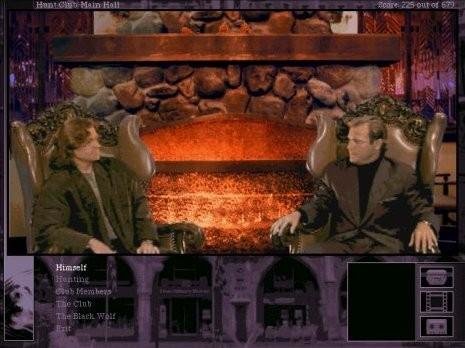
The unabashed reverence held for The Beast Within is all about the story. The streamlined gameplay – at least in comparison to the other two chapters of the Gabriel Knight trilogy – may not be everyone's cup of tea, and the full-motion video presentation is a divisive one amongst adventurers. But there's ample reason why the 1995 sequel is still considered an essential landmark of the genre. Jane Jensen, widely considered the best writer and game designer of the acclaimed Sierra stable, once again penned a rich, riveting script that tackled some deeply thought-provoking themes head-on, like Gabriel’s struggle to accept himself and evolve from the egotism of childhood into the conscious acceptance of adult responsibilities. He also suffers a philosophical dichotomy between the two halves of his soul; the Apollonian reason, order, and progress vs. Dionysian irrationality, chaos, destruction, embodied in the story by the polar opposites of Grace and Von Glower, respectively.
These inspiring themes emerge organically from a spellbinding plot that spans almost three centuries, encompassing the early history of the Ritter family and King Ludwig II of Bavaria, the long-lost opera of Richard Wagner, and the political machinations of Otto Von Bismark. The rich tale masterfully infuses a supernatural element as well – werewolves in this case – to illuminate human nature. The story is further deepened by some of the most fascinating characters ever to grace the genre, like the eminently charismatic Baron Friedrich Von Glower, brought to life by the talented Peter J. Lucas. It's an enthralling tale, and even if you don't usually like FMV, this game can't help but grab you by the throat from the very beginning to its sublime and heart-wrenching finale. The Beast Within certainly brought the best of Jane Jensen out, and to this day her script remains arguably the best the genre has ever seen.
#2 – The Longest Journey
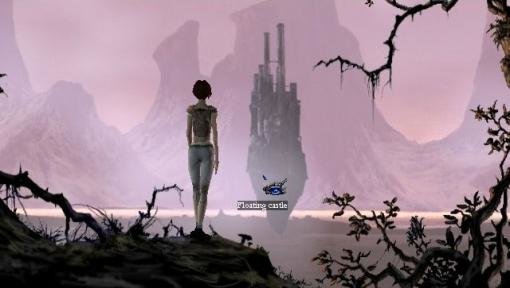
The new millennium kicked off in fine fashion, as Funcom's Ragnar Tørnquist crafted a vivid tale of two worlds in The Longest Journey: a world of fantasy and a world of science, each tied together by an unforgettable protagonist, April Ryan. A budding artist, April’s just an ordinary girl just trying to live her life – an ordinary girl who happens to have the ability to “shift” between magical Arcadia and scientific Stark. With no knowledge of these powers at first, or even the existence of another world, April begins both a personal journey to discover who she really is and a literal journey as she attempts to understand her role in the increasing imbalance between chaos and order. The game takes time to tell its story and establish rich characterizations, with long, edgy, and at times very adult dialogues with a vast cast of characters, from the mysterious Cortez to April’s lesbian landlady to the nefarious wizard Roper Klacks. And when you’re not immersed in deep conversation, you’ll be grappling with nearly Rube Goldberg-esque inventory puzzles.
It all adds up to an epic tale, the likes of which we really haven’t seen since. But there’s much more to this game than writing. More than a decade after release, Arcadia is still as magical as ever with its sprawling sea ports and lush forests filled with strange characters; scientific Stark, in its faded glory, is just as gritty, full of personality and paranoia. Even now, the cinematic cutscenes and beautifully artistic environments manage to inspire awe with swooping camera shots and majestic vistas, and the voice work is pitch-perfect in bringing such a diverse cast to life. In fact, it’s hard to believe it’s been around as long as it has. Back in the day, many considered the story-driven adventure a dying breed, unceremoniously swept aside by fast-paced action and console gaming. With The Longest Journey, Tørnquist’s storytelling prowess and vision not only created a quintessential point-and-click adventure that remains among the best the genre has ever seen, the game also brought some much needed inspiration back that helped show the way for those who followed.
#1 – Grim Fandango
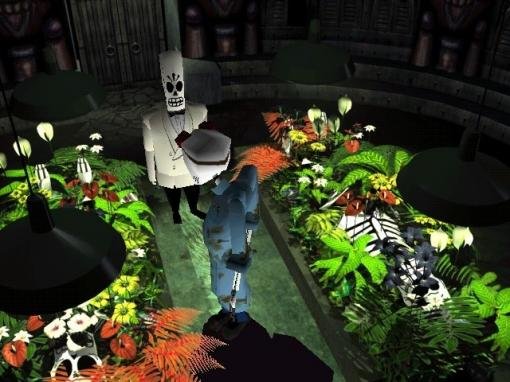
There is a long-standing idea that no game should receive a perfect score because no game is perfect. There are those who might nitpick and say that Grim Fandango's wonky controls or blocky character models should prevent it from being considered perfect. Well, fine. Tim Schafer’s magnum opus may not be perfect, but it's as close as any game in the genre has ever come. Landing at the tail-end of the Golden Age of adventure gaming (by 1998 adventure games were far, far away from the limelight), this epic tale of skeletal travel agent Manny Calavera's four-year journey through the Land of the Dead infuses the mythos of the Mexican Día de Muertos with film noir atmosphere and archetypes, bebop and jazz, beat culture, and even hot-rod fetishism, all glued together with the best of the best of LucasArts' trademark wit and humour. It sounds absurd, and it sometimes is, but it works beautifully, as if there were no more natural mash-up of influences.
The game's memorable characters are nearly overshadowed by breathtaking environments full of clever ideas and devious puzzles. The Land of the Dead is home to unforgettable characters like Glottis the lovable gearhead demon, sleazy fellow travel agent/con-man Domino Hurley, and zealous revolutionary Sal Limones. You'll visit magical places like the seedy Casablanca-inspired Rubacava and a coral mining plant at the Edge of the World. And all of this is set to Peter McConnell's classic score that is a masterpiece in its own right, mixing jazz, mariachi, and classical film score influences. Despite selling poorly at the time, Grim Fandango's star has risen over time, and it now holds a place of hushed reverence (or gushing praise) in the hearts of adventure gamers. It may not have the most incredible graphics, the funniest lines, or the cleverest puzzles, but it has an utterly unique alchemy of those elements that leads to something sublime. Seriously – being dead has never been so enjoyable.
And there it is! Adventure Gamers' Top 100 All-Time Adventures. Now there's nothing left but the tears, and a recap of the full list to come...
Whew! A hundred games. And we bet some of your favourites didn’t even make the list. Ours too!
The plan is to revisit the Top 100 each year, adding new games, removing older ones, and shuffling the existing order as necessary. It shouldn’t change too much year to year – these games are on it now for a reason! – but we’ll do our best to keep the list current from now on. Think we missed an unheralded gem? Let us know! But this Adventure Gamers’ Top 100 All-Time Adventures list for 2011.
Need a refresher? Here’s the condensed Top 100 games list in all its glory:
#100 – Titanic: Adventure Out Of Time
#99 – Nancy Drew: Curse of Blackmoor Manor
#98 – The Space Bar
#97 – Runaway: A Twist of Fate
#96 – Gold Rush!
#95 – Ripley's Believe it or Not!: The Riddle of Master Lu
#94 – Faust (aka Seven Games of the Soul)
#93 – Toonstruck
#92 – The Dig
#91 – The Feeble Files
#90 – Spycraft: The Great Game
#89 – The Journeyman Project 2: Buried in Time
#88 – Simon the Sorcerer II: The Lion, the Wizard and the Wardrobe
#87 – Penumbra: Black Plague
#86 – Dark Fall
#85 – The Dark Eye
#84 – The Colonel's Bequest: A Laura Bow Mystery
#83 – The Black Mirror
#82 – The 7th Guest
#81 – Quest for Glory II: Trial by Fire
#80 – Sherlock Holmes: The Awakened
#79 – Gemini Rue
#78 – Freddy Pharkas: Frontier Pharmacist
#77 – Silent Hill: Shattered Memories
#76 – Drawn: The Painted Tower
#75 – King’s Quest: Quest for the Crown
#74 – Shadow of the Comet
#73 – Discworld II
#72 – Maniac Mansion
#71 – Leisure Suit Larry: Love for Sail!
#70 – Amber: Journey's Beyond
#69 – I Have No Mouth, and I Must Scream
#68 – Shadow of Destiny (aka Shadow of Memories)
#67 – Pepper's Adventures in Time
#66 – Callahan's Crosstime Saloon
#65 – Hotel Dusk: Room 215
#64 – The Book of Unwritten Tales
#63 – Black Dahlia
#62 – Obsidian
#61 – Loom
#60 – Another Code (aka Trace Memory)
#59 – Myst III: Exile
#58 – Star Trek: Judgment Rites
#57 – Indigo Prophecy (aka Fahrenheit)
#56 – In Memoriam (aka MISSING: Since January)
#55 – Syberia II
#54 – Samorost 2
#53 – Return to Mysterious Island
#52 – Dreamfall: The Longest Journey
#51 – Zork: Nemesis
#50 – Infocom text adventures
#49 – Sam & Max: Season Two (aka Sam & Max Beyond Time and Space)
#48 – Space Quest IV: Roger Wilco and the Time Rippers
#47 – Professor Layton and the Curious Village
#46 – The Journeyman Project 3: Legacy of Time
#45 – The Curse of Monkey Island
#44 – Simon the Sorcerer
#43 – John Saul's Blackstone Chronicles
#42 – Conquests of the Longbow: The Legend of Robin Hood
#41 – Ghost Trick: Phantom Detective
#40 – Myst IV: Revelation
#39 – Last Window: The Secret of Cape West
#38 – Full Throttle
#37 – Stacking
#36 – Sanitarium
#35 – The Neverhood
#34 – Amnesia: The Dark Descent
#33 – L.A. Noire
#32 – Gabriel Knight: Blood of the Sacred, Blood of the Damned
#31 – Portal
#30 – Bad Mojo
#29 – Phoenix Wright: Ace Attorney
#28 – Sam & Max Hit the Road
#27 – Discworld Noir
#26 – Heavy Rain
#25 – Tex Murphy: Under a Killing Moon
#24 – Police Quest 2: The Vengeance
#23 – Quest for Glory IV: Shadows of Darkness
#22 – The Lost Files of Sherlock Holmes: The Case of the Serrated Scalpel
#21 – Blade Runner
#20 – Still Life
#19 – Beneath a Steel Sky
#18 – Myst
#17 – Machinarium
#16 – Gabriel Knight: Sins of the Fathers
#15 – Syberia
#14 – The Secret of Monkey Island
#13 – King's Quest VI: Heir Today, Gone Tomorrow
#12 – Zork Grand Inquisitor
#11 – Indiana Jones and the Fate of Atlantis
#10 – Portal 2
#9 – Tex Murphy: The Pandora Directive
#8 – Monkey Island 2: LeChuck's Revenge
#7 – The Last Express
#6 – Day of the Tentacle
#5 – Riven
#4 – Broken Sword: The Shadow of the Templars
#3 – Gabriel Knight: The Beast Within
#2 – The Longest Journey
#1 – Grim Fandango














